Biophilic Design in the Built Environment: Trends, Gaps and Future Directions
Abstract
1. Introduction
What Are the Trends and Gaps in Biophilic Design Research in the Built Environment?
- What are the main focus areas and directions in biophilic design research?
- Which building types, user groups, and climatic, regional and cultural contexts are represented/underrepresented?
- What methods and tools are commonly used, and where are the gaps?
- How are biophilic design parameters approached, holistically or partially, and which parameters dominate the literature?
- How is biophilic design connected to emerging fields?
2. Methodology
2.1. Data Search and Collection
- 421 studies were directly included after agreement between reviewers.
- 198 were excluded based on shared judgment.
- 31 studies with conflict or uncertainty (21 maybes, 10 disagreements) were resolved through panel review of four reviewers, and 17 were excluded.
- This process resulted in 435 publications being retained for analysis (see Supplementary Materials Table S1 for the complete list of publications).
2.2. Analysis of Bibliometric Data
- Trends in scientific production and country contributions.
- Author productivity and institutional collaboration networks.
- Journal impact and source relevance.
- Keyword co-occurrence and thematic mapping.
- International co-authorship and collaboration patterns.
2.3. Structured Content Analysis
- Type of Approach: whether biophilic design was the primary research focus or used as a supporting concept.
- Field and Scale: the spatial context of the study (e.g., architecture, interior, landscape).
- Methodological Strategy and Method Type: qualitative, quantitative, mixed-method, or theoretical.
- Research Theme: categorised into domains, such as architectural practice, education, standards, theory, and policy.
- Climate Reference and Country/Region.
- Cultural References: religious, traditional, or heritage-oriented dimensions.
- Target Population: students, patients, workers, children, etc.
- Building Typology: schools, hospitals, offices, residential buildings, etc.
- Biophilic Design Parameters.
- Overall Approach: holistic or partial.
- Specific Parameters: light, vegetation, water, natural materials, sound, scent, thermal comfort, and other sensory/environmental aspects.
3. Analysis of Bibliometric Insights of Biophilic Design Research
3.1. Annual Scientific Production
3.2. Geographic and Institutional Contributions
3.3. Authorship and Collaboration
3.4. Influential Journals
3.5. Keyword Trends and Thematic Directions
4. Structured Content Analysis of Biophilic Design Research
4.1. Methodological Strategies
4.2. Biophilic Design Research in Practice
4.2.1. Geographic Focus of Case Studies
4.2.2. Cultural Considerations
4.2.3. Climate-Specific Analysis
4.2.4. Population Focus
4.2.5. Building Typology
4.2.6. COVID-19 Focus
4.3. Theory, Heritage, Standards/Regulations, and Education
4.4. Biophilic Design Parameters
4.4.1. Parameter-Focused Studies
4.4.2. Most Frequently Mentioned Parameters Overall
5. Trends, Gaps, and Future Directions in Biophilic Design Research
5.1. Emerging Research Trends
5.2. Gaps and Limitations in the Current Literature
5.3. Future Directions for Biophilic Design Research
5.4. Limitations of This Study
6. Conclusions
Supplementary Materials
Author Contributions
Funding
Data Availability Statement
Acknowledgments
Conflicts of Interest
References
- Colman, A.M. A Dictionary of Psychology; Oxford quick reference: Oxford, UK, 2015. [Google Scholar]
- Fromm, E. The Heart of Man; Evanston: New York, NY, USA; Harper and Row Publishers: London, UK, 1964. [Google Scholar]
- Wilson, E. Biophilia. 1984. Available online: https://www.degruyter.com/document/doi/10.4159/9780674045231/html (accessed on 17 June 2021).
- Kellert, S.; Wilson, E.O. The Biophilia Hypothesis; Island Press: Washington, DC, USA, 1993. [Google Scholar]
- Kellert, S.; Heerwagen, J.; Mador, M. Biophilic Design: The Theory, Science and Practice of Bringing Buildings to Life; John Wiley & Sons Ltd.: Hoboken, NJ, USA, 2008. [Google Scholar]
- Tekin, B.H. Human-Centred Therapeutic Environments: A New Framework for Biophilic Design. Ph.D. Thesis, The University of Liverpool (United Kingdom), Liverpool, UK, 2022. [Google Scholar]
- Molthrop, E. Biophilic Design: A Review of Principle and Practice. Dartm. Undergrad. J. Sci. 2011, 2, 37–39. Available online: http://dujs.dartmouth.edu/wp-content/uploads/2011/06/11s_final-37-39.pdf (accessed on 20 March 2025).
- Ulrich, R.S.; Simons, R.F.; Losito, B.D.; Fiorito, E.; Miles, M.A.; Zelson, M. Stress recovery during exposure to natural and urban environments. J. Environ. Psychol. 1991, 11, 201–230. [Google Scholar] [CrossRef]
- Lohr, V.I.; Pearson-Mims, C.H.; Goodwin, G.K. Interior plants may improve worker productivity and reduce stress in a windowless environment. J. Environ. Hortic. 1996, 14, 97–100. [Google Scholar] [CrossRef]
- Kaplan, S. The restorative benefits of nature: Toward an integrative framework. J. Environ. Psychol. 1995, 15, 169–182. [Google Scholar] [CrossRef]
- Lee, J.; Lee, H. A comparison of nature and urban environments on psychological and physiological stress reduction. Front. Psychol. 2021, 12, 607287. [Google Scholar]
- Fredrickson, B.L.; Joiner, T. Positive emotions trigger upward spirals toward emotional well-being. Psychol. Sci. 2002, 13, 172–175. [Google Scholar] [CrossRef] [PubMed]
- Xing, Y.; Stevenson, N.; Thomas, C.; Hardy, A.; Knight, A.; Heym, N.; Sumich, A.; Arnout, B.A. Exploring biophilic building designs to promote wellbeing and stimulate inspiration. PLoS ONE 2025, 20, e0317372. [Google Scholar] [CrossRef] [PubMed]
- Xing, Y.; Williams, A.; Knight, A. Developing a biophilic behavioural change design framework—A scoping study. Urban For. Urban Green. 2024, 94, 128278. [Google Scholar] [CrossRef]
- Ulrich, R.S. View through a window may influence recovery from surgery. Science 1984, 224, 420–421. [Google Scholar] [CrossRef] [PubMed]
- Park, B.-J.; Tsunetsugu, Y.; Kasetani, T.; Morikawa, T.; Kagawa, T.; Miyazaki, Y. Physiological Effects of Forest Recreation in a Young Conifer Forest in Hinokage Town, Japan. Silva Fenn. 2009, 43, 291–301. [Google Scholar] [CrossRef]
- Figueiro, M.G.; Rea, M.S. Office lighting and personal light exposures in two seasons: Impact on sleep and mood. Light. Res. Technol. 2014, 48, 352–364. [Google Scholar] [CrossRef]
- Sadler, B.L.; DuBose, J.; Malone, E.; Zimring, C.M. The business case for building better hospitals through evidence-based design. Health Environ. Res. Des. J. 2020, 13, 95–114. [Google Scholar] [CrossRef] [PubMed]
- Park, S.-H.; Mattson, R.H. Therapeutic influences of plants in hospital rooms on surgical recovery. HortScience 2009, 44, 102–105. [Google Scholar] [CrossRef]
- Tekin, B.H.; Corcoran, R.; Gutiérrez, R.U. A Systematic Review and Conceptual Framework of Biophilic Design Parameters in Clinical Environments. Health Environ. Res. Des. J. 2022, 16, 233–250. [Google Scholar] [CrossRef] [PubMed]
- Kaplan, R.; Kaplan, S. The Experience of Nature: A Psychological Perspective; Cambridge university press: Cambridge, UK, 1989. [Google Scholar]
- Berman, M.G.; Jonides, J.; Kaplan, S. The cognitive benefits of interacting with nature. Psychol. Sci. 2008, 19, 1207–1212. [Google Scholar] [CrossRef] [PubMed]
- Tennessen, C.M.; Cimprich, B. Views to nature: Effects on attention. J. Environ. Psychol. 1995, 15, 77–85. [Google Scholar] [CrossRef]
- Dadvand, P.; Nieuwenhuijsen, M.J.; Esnaola, M.; Forns, J.; Basagaña, X.; Alvarez-Pedrerol, M.; Rivas, I.; López-Vicente, M.; De Castro Pascual, M.; Su, J.; et al. Green spaces and cognitive development in primary schoolchildren. Proc. Natl. Acad. Sci. USA 2015, 112, 7937–7942. [Google Scholar] [CrossRef] [PubMed]
- Raanaas, R.K.; Evensen, K.H.; Rich, D.; Sjostrom, G.; Patil, G.G. Benefits of indoor plants on attention capacity in an office setting. J. Environ. Psychol. 2011, 31, 99–105. [Google Scholar] [CrossRef]
- Van Rompay, T.J.L.; Jol, T. Wild and free: Unpredictability and spaciousness as predictors of creative performance. J. Environ. Psychol. 2016, 48, 140–148. [Google Scholar] [CrossRef]
- Beukeboom, C.J.; Langeveld, D.; Tanja-Dijkstra, K. Stress-reducing effects of real and artificial nature in a hospital waiting room. J. Altern. Complement. Med. 2012, 18, 329–333. [Google Scholar] [CrossRef] [PubMed]
- Shibata, S.; Suzuki, N. Effects of an indoor plant on creative task performance and mood. Scand. J. Psychol. 2004, 45, 373–381. [Google Scholar] [CrossRef] [PubMed]
- Barrett, P.; Zhang, Y.; Moffat, J.; Kobbacy, K. A holistic, multi-level analysis identifying the impact of classroom design on pupils’ learning. Build. Environ. 2013, 59, 678–689. [Google Scholar] [CrossRef]
- Nieuwenhuis, M.; Knight, C.; Postmes, T.; Haslam, S.A. The relative benefits of green versus lean office space: Three field experiments. J. Exp. Psychol. Appl. 2014, 20, 199–214. [Google Scholar] [CrossRef] [PubMed]
- Heschong, L. Daylighting in Schools: Reanalysis Report; California energy Commission: California, CA, USA, 2003. [Google Scholar]
- Heschong, L.; Mahone, D. Windows and Offices: A Study of Office Worker Performance and the Indoor Environment; California Energy Commission: California, CA, USA, 2003; pp. 1–5. [Google Scholar]
- United Nations. 68% of the World Population Projected to Live in Urban Areas by 2050, Says UN | UN DESA | United Nations Department of Economic and Social Affairs. Available online: https://www.un.org/development/desa/en/news/population/2018-revision-of-world-urbanization-prospects.html (accessed on 5 August 2022).
- Allen, J.G.; MacNaughton, P.; Satish, U.; Santanam, S.; Vallarino, J.; Spengler, J.D. Associations of cognitive function scores with carbon dioxide, ventilation, and volatile organic compound exposures in office workers: A controlled exposure study of green and conventional office environments. Environ. Health Perspect. 2016, 124, 805–812. [Google Scholar] [CrossRef] [PubMed]
- Avery, D.H.; Kizer, D.; Bolte, M.A.; Hellekson, C. Bright Light Therapy of Subsyndromal Seasonal Sffective Disorder in the Workplace: Morning vs. Afternoon Exposure. Acta Psychiatr. Scand. 2001, 103, 267–274. [Google Scholar] [CrossRef] [PubMed]
- Wirz-Justice, A.; Graw, P.; Kräuchi, K.; Sarrafzadeh, A.; English, J.; Arendt, J.; Sand, L. ‘Natural’ light treatment of seasonal affective disorder. J. Affect. Disord. 1996, 37, 109–120. [Google Scholar] [CrossRef] [PubMed]
- Burge, P.S.; Jones, P.; Robertson, A.S. Sick Building Syndrome Environmental Comparisons of Sick and Healthy Buildings. Indoor Air 1990, 1, 479–483. [Google Scholar]
- Niza, I.L.; de Souza, M.P.; da Luz, I.M.; Broday, E.E. Sick building syndrome and its impacts on health, well-being and productivity: A systematic literature review. Indoor Built Environ. 2024, 33, 218–236. [Google Scholar] [CrossRef]
- Al-Khayyat, A.; Şahin, N.P. Interrelating the Concepts of Sick Building Syndrome and Biophilic Design to Enhance Occupants Well-Being in Interior Environments: An Overview. 2024. Available online: https://ssrn.com/abstract=4954976 (accessed on 17 June 2025).
- Beute, F.; de Kort, Y.A.W. Salutogenic effects of the environment: Review of health protective effects of nature and daylight. Appl. Psychol. Health Well-Being 2013, 6, 67–95. [Google Scholar] [CrossRef] [PubMed]
- Ulrich, R.S. Aesthetic and affective response to natural environment. In Behavior and the Natural Environment; Springer: Boston, MA, USA, 1983; pp. 85–125. [Google Scholar]
- Ulrich, R.S. Evidence based environmental design for improving medical outcomes. In Proceedings of the Healing by Design: Building for Health Care in the 21st Century Conference, Montreal, QC, Canada, 20–21 September 2000; pp. 1–3. Available online: https://www.brikbase.org/sites/default/files/Evidence%20Based%20Environmental%20Design%20for%20Improving%20Medical.pdf (accessed on 8 May 2022).
- Hamilton, D.K.; Watkins, D.H. Evidence-Based Design for Multiple Building Types; John Wiley & Sons: Hoboken, NJ, USA, 2008. [Google Scholar]
- Smith, R.; Watkins, N. Therapeutic Environments | WBDG—Whole Building Design Guide. Available online: https://www.wbdg.org/resources/therapeutic-environments (accessed on 17 June 2021).
- Freimane, E. Healing Design. Design Experience Challenges; Latvian Designers Society: Riga, Latvia, 2013; p. 15. Available online: http://old2023.design.lv/wp-content/uploads/2015/05/LDS_konf_raksti_2015-1.pdf (accessed on 17 June 2025).
- Ulrich, R.S.; Zimring, C.; Zhu, X.; DuBose, J.; Seo, H.-B.; Choi, Y.-S.; Quan, X.; Joseph, A. A review of the research literature on evidence-based healthcare design. HERD Health Environ. Res. Des. J. 2008, 1, 61–125. [Google Scholar] [CrossRef] [PubMed]
- Antonovsky, A. Health, Stress, and Coping; Jossey-Bass: San Francisco, CA, USA, 1979. [Google Scholar]
- Dilani, A. Design for Paediatric Health, Designing a solutogenic children’s hospital. Health Manag. 2014, 14. Available online: https://healthmanagement.org/c/healthmanagement/issuearticle/design-for-paediatric-health (accessed on 4 July 2022).
- Dilani, A. Psychosocially supportive design: A salutogenic approach to the design of the physical environment. Des. Health Sci. Rev. 2008, 1, 47–55. Available online: https://healingattention.org/wp-content/uploads/Psychosocially_Supportive_Design_A_Salutogenic_App.pdf (accessed on 8 May 2022).
- Mazuch, R. Salutogenic and biophilic design as therapeutic approaches to sustainable architecture. Arch. Des. 2017, 87, 42–47. [Google Scholar] [CrossRef]
- Wang, S.; de Oliveira, G.S.; Djebbara, Z.; Gramann, K. The Embodiment of Architectural Experience: A Methodological Perspective on Neuro-Architecture. Front. Hum. Neurosci. 2022, 16, 833528. [Google Scholar] [CrossRef] [PubMed]
- Higuera-Trujillo, J.L.; Llinares, C.; Macagno, E. The Cognitive-Emotional Design and Study of Architectural Space: A Scoping Review of Neuroarchitecture and Its Precursor Approaches. Sensors 2021, 21, 2193. [Google Scholar] [CrossRef] [PubMed]
- Abbas, S.; Okdeh, N.; Roufayel, R.; Kovacic, H.; Sabatier, J.-M.; Fajloun, Z.; Khattar, Z.A. Neuroarchitecture: How the Perception of Our Surroundings Impacts the Brain. Biology 2024, 13, 220. [Google Scholar] [CrossRef] [PubMed]
- Assem, H.M.; Khodeir, L.M.; Fathy, F. Designing for human wellbeing: The integration of neuroarchitecture in design—A systematic review. Ain Shams Eng. J. 2023, 14, 102102. [Google Scholar] [CrossRef]
- Farrow, T. How the Built Environment Enhances Your Mind’s Health; University of Toronto Press: Toronto, Canada, 2024. [Google Scholar] [CrossRef]
- Valentine, C.; Mitcheltree, H.; Sjövall, I.A.K.; Khalil, M.H. Architecturally Mediated Allostasis and Neurosustainability: A Proposed Theoretical Framework for the Impact of the Built Environment on Neurocognitive Health. Brain Sci. 2025, 15, 201. [Google Scholar] [CrossRef] [PubMed]
- Kellert, S.; Calabrese, E. The Practice of Biophilic Design. 2015. Available online: https://www.biophilic-design.com (accessed on 23 March 2021).
- Browning, W.D.; Ryan, C.O.; Clancy, J.O. 14 Patterns of Biophilic Design: Improving Health & Well-Being in the Built Environment, no. 2. Terrapin Bright Green, LLC. 2014. Available online: https://www.terrapinbrightgreen.com/wp-content/uploads/2014/09/14-Patterns-of-Biophilic-Design-Terrapin-2014p.pdf (accessed on 25 May 2025).
- Tekin, B.H.; Gutiérrez, R.U. Human-centred health-care environments: A new framework for biophilic design. Front. Med. Technol. 2023, 5, 1219897. [Google Scholar] [CrossRef] [PubMed]
- Tekin, B.H.; Corcoran, R.; Gutiérrez, R.U. The impact of biophilic design in Maggie’s Centres: A meta-synthesis analysis. Front. Arch. Res. 2023, 12, 188–207. [Google Scholar] [CrossRef]
- Ding, X.; Cui, Y.; Chen, Z.; Zhang, H. Energy Efficiency in Biophilic Architecture: A Systematic Literature Review and Visual Analysis Using CiteSpace and VOSviewer. Buildings 2024, 14, 3800. [Google Scholar] [CrossRef]
- Tirri, C.; Swanson, H.; Meenar, M. Finding the ‘Heart’ in the Green: Conducting a Bibliometric Analysis to Emphasize the Need for Connecting Emotions with Biophilic Urban Planning. Int. J. Environ. Res. Public Health 2021, 18, 9435. [Google Scholar] [CrossRef] [PubMed]
- Liu, W. The data source of this study is Web of Science Core Collection? Not enough. Scientometrics 2019, 121, 1815–1824. [Google Scholar] [CrossRef]
- Team, R.C.; R: The R Project for Statistical Computing. R Foundation for Statistical Computing, Vienna, Austria (2016). Available online: https://www.r-project.org/ (accessed on 25 May 2025).
- Aria, M.; Cuccurullo, C. bibliometrix: An R-tool for comprehensive science mapping analysis. J. Informetr. 2017, 11, 959–975. [Google Scholar] [CrossRef]
- Ouzzani, M.; Hammady, H.; Fedorowicz, Z.; Elmagarmid, A. Rayyan-a web and mobile app for systematic reviews. Syst. Rev. 2016, 5, 210. [Google Scholar] [CrossRef] [PubMed]
- Singh, V.K.; Singh, P.; Karmakar, M.; Leta, J.; Mayr, P. The journal coverage of Web of Science, Scopus and Dimensions: A comparative analysis. Scientometrics 2021, 126, 5113–5142. [Google Scholar] [CrossRef]
- Gür, M.; Kaprol, T.; Gür, M.; Kaprol, T. The Participation of Biophilic Design in the Design of the Post-Pandemic Living Space; IGI Global Scientific Publishing: Hershey, PA, USA, 2022; pp. 75–106. [Google Scholar] [CrossRef]
- Watchman, M.; Demers, C.M.H.; Potvin, A. Biophilia in school buildings: Towards a simplified assessment method based on spatial geometry. Arch. Eng. Des. Manag. 2021, 18, 434–452. [Google Scholar] [CrossRef]
- Parsaee, M.; Demers, C.M.; Hébert, M.; Lalonde, J.F.; Potvin, A. A photobiological approach to biophilic design in extreme climates. Build. Environ. 2019, 154, 211–226. [Google Scholar] [CrossRef]
- Tabatabaeifard, S.A.; Lalonde, J.F.; Hébert, M.; Potvin, A.; Demers, C.M. Exploring view access for biophilic arctic architecture through immersive visualization of integrative lighting. J. Build. Eng. 2023, 69, 106249. [Google Scholar] [CrossRef]
- Espinoza-Sanhueza, C.; Hébert, M.; Lalonde, J.F.; Demers, C.M.H. Exploring light and colour patterns for remote biophilic northern architecture. Indoor Built Environ. 2023, 33, 359–376. [Google Scholar] [CrossRef]
- Abazari, T.; Potvin, A.; Demers, C.M.H.; Gosselin, L. A biophilic wellbeing framework for positive indoor-outdoor connections in energy-efficient Arctic buildings. Build. Environ. 2022, 226, 109773. [Google Scholar] [CrossRef]
- Cacique, M.; Ou, S.J. Biophilic Design as a Strategy for Accomplishing the Idea of Healthy, Sustainable, and Resilient Environments. Sustainability 2022, 14, 560. [Google Scholar] [CrossRef]
- Radha, C.H. Biophilic Design Approach for Improving Human Health in the Built Environment. Int. Trans. J. Eng. Manag. Appl. Sci. Technol. 2022, 13, 1–12. [Google Scholar] [CrossRef]
- Gillis, K.; Gatersleben, B. A Review of Psychological Literature on the Health and Wellbeing Benefits of Biophilic Design. Buildings 2015, 5, 948–963. [Google Scholar] [CrossRef]
- Ryan, C.O.; Browning, W.D.; O Clancy, J.; Andrews, S.L.; Kallianpurkar, N.B. Biophilic Design Patterns Emerging Nature-Based Parameters for Health and Well-Being in the Built Environment. Archnet-IJAR Int. J. Arch. Res. 2014, 8, 62–76. [Google Scholar] [CrossRef]
- Söderlund, J.; Newman, P. How the biophilic design social movement informs planning, policy and professional practice. Sustain. Earth 2022, 5, 4. [Google Scholar] [CrossRef]
- Putrino, D.; Ripp, J.; Herrera, J.E.; Cortes, M.; Kellner, C.; Rizk, D.; Dams-O’cOnnor, K. Multisensory, Nature-Inspired Recharge Rooms Yield Short-Term Reductions in Perceived Stress Among Frontline Healthcare Workers. Front. Psychol. 2020, 11, 560833. [Google Scholar] [CrossRef] [PubMed]
- Valentine, C.; Steffert, T.; Mitcheltree, H.; Steemers, K. Architectural Neuroimmunology: A Pilot Study Examining the Impact of Biophilic Architectural Design on Neuroinflammation. Buildings 2024, 14, 1292. [Google Scholar] [CrossRef]
- Maestre, C.A.; Garza, S.; Albornoz, Y.; Mejia-Arango, S.; Melgarejo, J.D.; Maestre, G.E. Impacts of imageability of architecture on brain health: A systematic literature review. Landsc. Urban Plan. 2024, 256, 105286. [Google Scholar] [CrossRef]
- Wang, M.; Liu, X.; Lai, Y.; Cao, W.; Wu, Z.; Guo, X. Application of Neuroscience Tools in Building Construction—An Interdisciplinary Analysis. Front. Neurosci. 2022, 16, 895666. [Google Scholar] [CrossRef] [PubMed]
- Mehaffy, M.W.; Salingaros, N.A.; Lavdas, A.A. The ‘Modern’ Campus: Case Study in (Un)Sustainable Urbanism. Sustainability 2023, 15, 16427. [Google Scholar] [CrossRef]
- Dwivedi, Y.K.; Sharma, A.; Rana, N.P.; Giannakis, M.; Goel, P.; Dutot, V. Evolution of artificial intelligence research in Technological Forecasting and Social Change: Research topics, trends, and future directions. Technol. Forecast. Soc. Chang. 2023, 192, 122579. [Google Scholar] [CrossRef]
- Ramm, T.M.; Werwie, M.; Otto, T.; Gloor, P.A.; Salingaros, N.A. Artificial Intelligence Evaluates How Humans Connect to the Built Environment: A Pilot Study of Two Experiments in Biophilia. Sustainability 2024, 16, 868. [Google Scholar] [CrossRef]
- Xing, Y.; Kar, P.; Bird, J.J.; Sumich, A.; Knight, A.; Lotfi, A.; van Barthold, B.C. Developing an AI-Based Digital Biophilic Art Curation to Enhance Mental Health in Intelligent Buildings. Sustainability 2024, 16, 9790. [Google Scholar] [CrossRef]
- Tunahan, G.I.; Altamirano, H.; Teji, J.U.; Ticleanu, C. Evaluation of Daylight Perception Assessment Methods. Front. Psychol. 2022, 13, 805796. [Google Scholar] [CrossRef] [PubMed]
- Zhang, M.; Du, J.; Yang, M. Biophilia and visual preference for Chinese vernacular windows: An investigation into shape. J. Asian Arch. Build. Eng. 2022, 22, 2448–2459. [Google Scholar] [CrossRef]
- Shbaita, A.S.; Denerel, S.B.; Asilsoy, B. An Evidence-Based Assessment of Biophilic Interior Design in a Traditional Context: The Case of the Kingdom of Saudi Arabia. Sustainability 2024, 16, 7979. [Google Scholar] [CrossRef]
- Almusaed, A.; Alasadi, A.; Almssad, A. A Research on the Biophilic Concept upon School’s Design from Hot Climate: A Case Study from Iraq. Adv. Mater. Sci. Eng. 2022, 2022, 7994999. [Google Scholar] [CrossRef]
- Africa, J.; Heerwagen, J.; Loftness, V.; Balagtas, C.R. Biophilic design and climate change: Performance parameters for health. Front. Built Environ. 2019, 5, 28. [Google Scholar] [CrossRef]
- Tekin, B.H. SIMILARITIES IN THE PERCEPTION OF ECOLOGICAL AND BIOPHILIC DESIGN|Request PDF. In Proceedings of the Conference on Climate Change, Sustainability, and International Cooperation (CLICS), Düzce, Türkiye, 21–22 February 2024; pp. 126–136. Available online: https://www.researchgate.net/publication/378697858_SIMILARITIES_IN_THE_PERCEPTION_OF_ECOLOGICAL_AND_BIOPHILIC_DESIGN (accessed on 26 May 2025).
- Bettaieb, D.M.; Alsabban, R.F. Users’ role in applying biophilic attributes to the interiors of residential spaces. Open House Int. 2022, 48, 163–184. [Google Scholar] [CrossRef]
- Ebrahimpour, M. Proposing a Framework of Biophilic Design Principles in Hot and Arid Climate of Iran by Using Grounded Theory. Civ. Environ. Eng. 2020, 16, 71–78. [Google Scholar] [CrossRef]
- Atthakorn, S. Passive and Biophilic Design: Assessment of the Semi-Open Educational Atrium Buildings in the Tropics. Nakhara. J. Environ. Des. Plan. 2022, 21, 203. [Google Scholar] [CrossRef]
- Salari, E.E.; Westbrook, N. Ascending to Well-Being through Mediated Spaces: An Alternative to Informal Learning and Physical Activity Environments in Vertical Schools. Architecture 2024, 4, 613–638. [Google Scholar] [CrossRef]
- Watchman, M.; Demers, C.M.H.; Potvin, A. Biophilic School Architecture in Cold Climates; SAGE Publications Ltd.: London, UK, 2021. [Google Scholar] [CrossRef]
- Shakhshir, K.; Sheta, W. The assessment of biophilic features in residential buildings: A case from Dubai. Archnet-IJAR Int. J. Arch. Res. 2023, 18, 247–267. [Google Scholar] [CrossRef]
- Abazari, T.; Potvin, A.; Gosselin, L.; Demers, C.M.H. Developing biophilic intermediate spaces for Arctic housing: Optimizing the thermal, visual, and energy performance. Build. Simul. 2024, 17, 857–875. [Google Scholar] [CrossRef]
- Espinoza-Sanhueza, C.; Hébert, M.; Lalonde, J.F.; Demers, C.M. Biophilic analogous patterns for light-responsive architecture during polar night: Examining the photobiological effects of electrical lighting on surface colour configuration. Build. Environ. 2023, 249, 111125. [Google Scholar] [CrossRef]
- Al Khatib, I.; Samara, F.; Ndiaye, M. A systematic review of the impact of therapeutical biophilic design on health and wellbeing of patients and care providers in healthcare services settings. Front. Built Environ. 2024, 10, 1467692. [Google Scholar] [CrossRef]
- Sanchez, J.A.; Ikaga, T.; Sanchez, S.V. Quantitative improvement in workplace performance through biophilic design: A pilot experiment case study. Energy Build. 2018, 177, 316–328. [Google Scholar] [CrossRef]
- Browning, W.; Determan, J. Outcomes of Biophilic Design for Schools. Architecture 2024, 4, 479–492. [Google Scholar] [CrossRef]
- Lanzaro, B.; Ucci, M. Teacher and Parent Perception of Biophilic Conditions in Primary-School Environments and Their Impact on Children’s Wellbeing. Architecture 2024, 4, 367–389. [Google Scholar] [CrossRef]
- Neilson, B.N.; Craig, C.M.; Altman, G.C.; Travis, A.T.; Vance, J.A.; Klein, M.I. Can the Biophilia Hypothesis Be Applied to Long-Duration Human Space Flight? A Mini-Review. Front. Psychol. 2021, 12, 703766. [Google Scholar] [CrossRef] [PubMed]
- Chammas, A.; Quaresma, M.; Mont’Alvão, C. A Closer Look on the User Centred Design. Procedia Manuf. 2015, 3, 5397–5404. [Google Scholar] [CrossRef]
- Lei, Q.; Yuan, C.; Lau, S.S.Y. A quantitative study for indoor workplace biophilic design to improve health and productivity performance. J. Clean. Prod. 2021, 324, 129168. [Google Scholar] [CrossRef]
- Peters, T.; D’Penna, K. Biophilic Design for Restorative University Learning Environments: A Critical Review of Literature and Design Recommendations. Sustainability 2020, 12, 7064. [Google Scholar] [CrossRef]
- Determan, J.; Mary, A.; Akers, M.A.A.; Albright, T.; Browning, B.; Martin-Dunlep, C.S.; Archibald, P.; Caruolo, V.S.; Macht, C. Impact of Biophilic Learning Spaces on Student Success. 2019. Available online: https://cgdarch.com/wp-content/uploads/2019/12/The-Impact-of-Biophilic-Learning-Spaces-on-Student-Success.pdf (accessed on 27 May 2025).
- Miola, L.; Boldrini, A.; Pazzaglia, F. The healing power of nature. Biophilic design applied to healthcare facilities. Curr. Opin. Psychol. 2025, 64, 102049. [Google Scholar] [CrossRef] [PubMed]
- Lee, E.-J.; Park, S.-J. Biophilic Experience-Based Residential Hybrid Framework. Int. J. Environ. Res. Public Health 2022, 19, 8512. [Google Scholar] [CrossRef] [PubMed]
- Lee, E.J.; Park, S.J. Toward the Biophilic Residential Regeneration for the Green New Deal. Int. J. Environ. Res. Public Health 2021, 18, 2523. [Google Scholar] [CrossRef] [PubMed]
- Söderlund, J.; Newman, P. Improving Mental Health in Prisons Through Biophilic Design. Prison. J. 2017, 97, 750–772. [Google Scholar] [CrossRef]
- Hakiminejad, Y.; Pantesco, E.; Tavakoli, A. Public transit of the future: Enhancing well-being through designing human-centered public transportation spaces. Transp. Res. Interdiscip. Perspect. 2025, 30, 101365. [Google Scholar] [CrossRef]
- Tereci, A. Biophilic wisdom of the thirteenth and fourteenth century Seljukians’ Mosque architecture in Beyşehir, Anatolia. Arch. Sci. Rev. 2019, 63, 3–14. [Google Scholar] [CrossRef]
- Aristizabal, S.; Byun, K.; Porter, P.; Clements, N.; Campanella, C.; Li, L.; Mullan, A.; Ly, S.; Senerat, A.; Nenadic, I.Z.; et al. Biophilic office design: Exploring the impact of a multisensory approach on human well-being. J. Environ. Psychol. 2021, 77, 101682. [Google Scholar] [CrossRef]
- Tashiro, S.; Harada, Y. Psychological and physiological thermal effects of biophilic built environment using virtual reality: A pilot study for certified green building. Build. Environ. 2025, 270, 112534. [Google Scholar] [CrossRef]
- Jung, D.; Kim, D.I.; Kim, N. Bringing nature into hospital architecture: Machine learning-based EEG analysis of the biophilia effect in virtual reality. J. Environ. Psychol. 2023, 89, 102033. [Google Scholar] [CrossRef]
- Zhong, W.; Schröder, T.; Bekkering, J. Implementing biophilic design in architecture through three-dimensional green spaces: Guidelines for building technologies, plant selection, and maintenance. J. Build. Eng. 2024, 92, 109648. [Google Scholar] [CrossRef]
- Maghlakelidze, M.; Mesa, A.; Sawyer, A.O.; Morad, M.G.; Ben-Alon, L. Biophilic design elements and natural materials in healthcare environments. J. Green Build. 2024, 19, 1–39. [Google Scholar] [CrossRef]
- Duffy, A.J. The ‘Nature’ of Vertical School Design—An Evolving Concept. Architecture 2024, 4, 730–744. [Google Scholar] [CrossRef]
- Gatersleben, B.; Andrews, M. When walking in nature is not restorative—The role of prospect and refuge. Health Place 2013, 20, 91–101. [Google Scholar] [CrossRef] [PubMed]
- Subramaniam, C.; Ismail, S.; Durdyev, S.; Rani, W.N.M.W.M.; Abu Bakar, N.F.S.; Banaitis, A. Overcoming the Project Communications Management Breakdown amongst Foreign Workers during the COVID-19 Pandemic in Biophilia Inveigled Construction Projects in Malaysia. Energies 2021, 14, 4790. [Google Scholar] [CrossRef]
- Solak, E.B.; Kisakurek, S. A study on the importance of home and balcony during the COVID-19 pandemic. Environ. Dev. Sustain. 2023, 26, 26345–26363. [Google Scholar] [CrossRef]
- Shulla, K.; Voigt, B.-F.; Lardjane, S.; Fischer, K.; Kędzierski, P.; Scandone, G.; Süße, T. People-environment relations following COVID-19 pandemic lifestyle restrictions: A multinational, explorative analysis of intended biophilic design changes. Discov. Sustain. 2024, 5, 229. [Google Scholar] [CrossRef]
- Bahador, A.; Zarandi, M.M. Biophilic design: An effective design approach during pandemic and post-pandemic. Facilities 2023, 42, 68–82. [Google Scholar] [CrossRef]
- Waheeb, M.I.; Hemeida, F.A. Study of natural ventilation and daylight in a multi-storey residential building to address the problems of COVID-19. Energy Rep. 2022, 8, 863–880. [Google Scholar] [CrossRef]
- Abdelaal, M.S.; Soebarto, V. History matters: The origins of biophilic design of innovative learning spaces in traditional architecture. Int. J. Arch. Res. Archnet-IJAR 2018, 12, 108–127. [Google Scholar] [CrossRef]
- Ramzy, N.S. Biophilic qualities of historical architecture: In quest of the timeless terminologies of ‘life’ in architectural expression. Sustain. Cities Soc. 2015, 15, 42–56. [Google Scholar] [CrossRef]
- Grazuleviciute-Vileniske, I.; Daugelaite, A.; Viliunas, G. Classification of Biophilic Buildings as Sustainable Environments. Buildings 2022, 12, 1542. [Google Scholar] [CrossRef]
- Jiang, B.; Song, Y.; Li, H.X.; Lau, S.S.Y.; Lei, Q. Incorporating biophilic criteria into green building rating tools: Case study of Green Mark and LEED. Environ. Impact Assess. Rev. 2020, 82, 106380. [Google Scholar] [CrossRef]
- Tu, H.M. Confirmative biophilic framework for heritage management. PLoS ONE 2022, 17, e0266113. [Google Scholar] [CrossRef] [PubMed]
- Sadick, A.M.; Kamardeen, I. Enablers for accelerating biophilic design adoption in Australian buildings. J. Build. Eng. 2024, 83, 108464. [Google Scholar] [CrossRef]
- Kayıhan, K.S.; Güney, S.Ö.; Ünal, F.C. Biophilia as the Main Design Question in Architectural Design Studio Teaching. Megaron 2018, 13, 1–12. [Google Scholar] [CrossRef]
- Ebbini, G.W. Transformative Design Pedagogy: Teaching Biophilic Design Through Experiential Learning. J. Exp. Educ. 2021, 45, 7–31. [Google Scholar] [CrossRef]
- Özbey, F.; Denerel, S.B. Student involvement and innovative teaching methods in a biophilic design education pilot elective course in interior architecture. Humanit. Soc. Sci. Commun. 2024, 11, 1155. [Google Scholar] [CrossRef]
- McGee, B.; Park, N.K. Beyond plants: Biophilic design as a pedagogical tool. Int. J. Des. Educ. 2021, 15, 209–228. [Google Scholar] [CrossRef]
- Dijkstra, K.; Pieterse, M.; Pruyn, A. Physical environmental stimuli that turn healthcare facilities into healing environments through psychologically mediated effects: Systematic review. J. Adv. Nurs. 2006, 56, 166–181. [Google Scholar] [CrossRef] [PubMed]
- Blaschke, S.; O’Callaghan, C.C.; Schofield, P. ‘Artificial but better than nothing’: The greening of an oncology clinic waiting room. Health Environ. Res. Des. J. 2017, 10, 51–60. [Google Scholar] [CrossRef] [PubMed]
- Liu, W.; Wang, H. Red alert: Millions of ‘homeless’ publications in Scopus should be resettled. J. Assoc. Inf. Sci. Technol. 2025, 1–9. [Google Scholar] [CrossRef]
- Savchenko, I.; Kosyakov, D. Lost in affiliation: Apatride publications in international databases. Scientometrics 2022, 127, 3471–3487. [Google Scholar] [CrossRef]
- Pranckutė, R. Web of Science (WoS) and Scopus: The Titans of Bibliographic Information in Today’s Academic World. Publications 2021, 9, 12. [Google Scholar] [CrossRef]
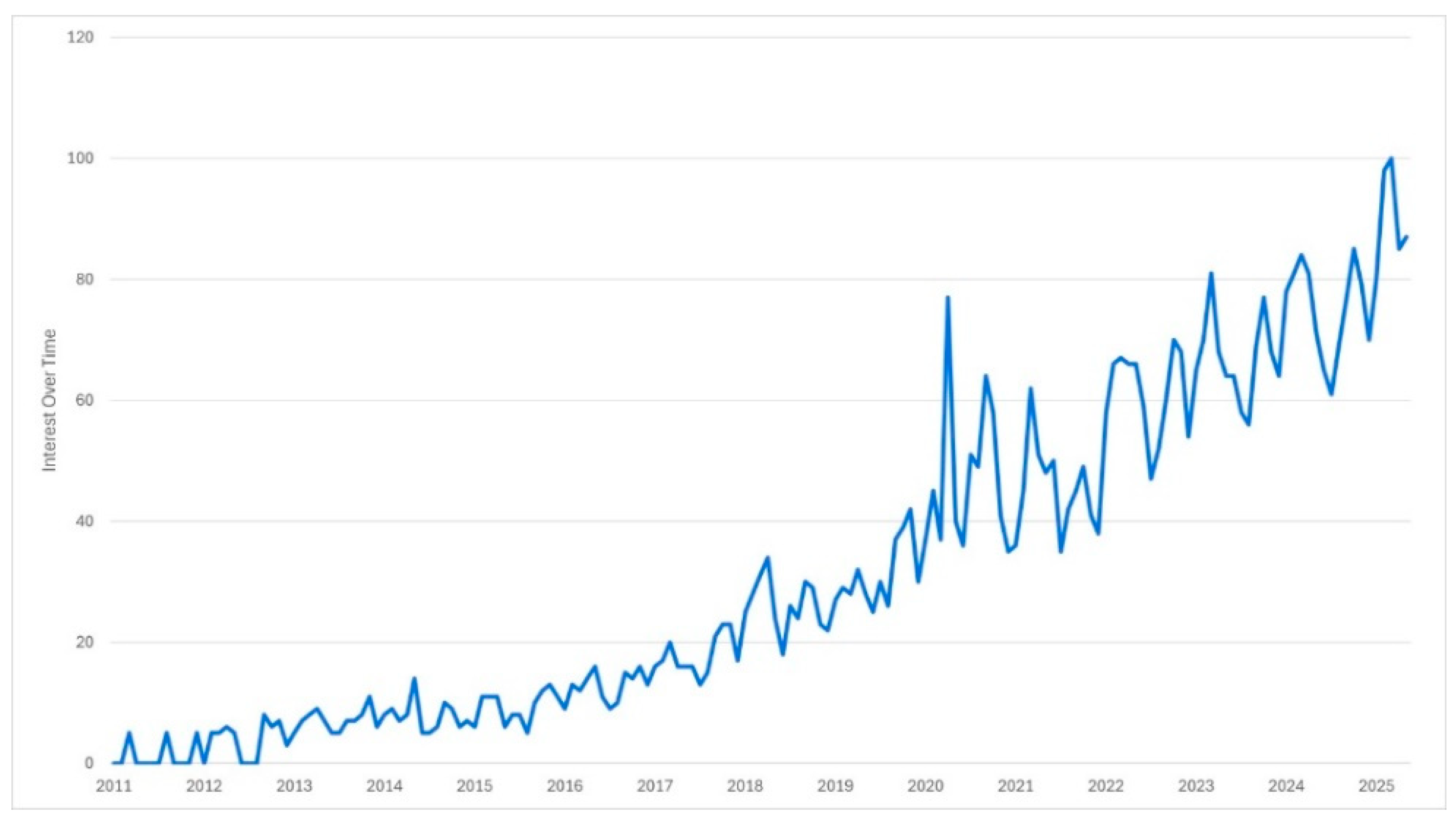
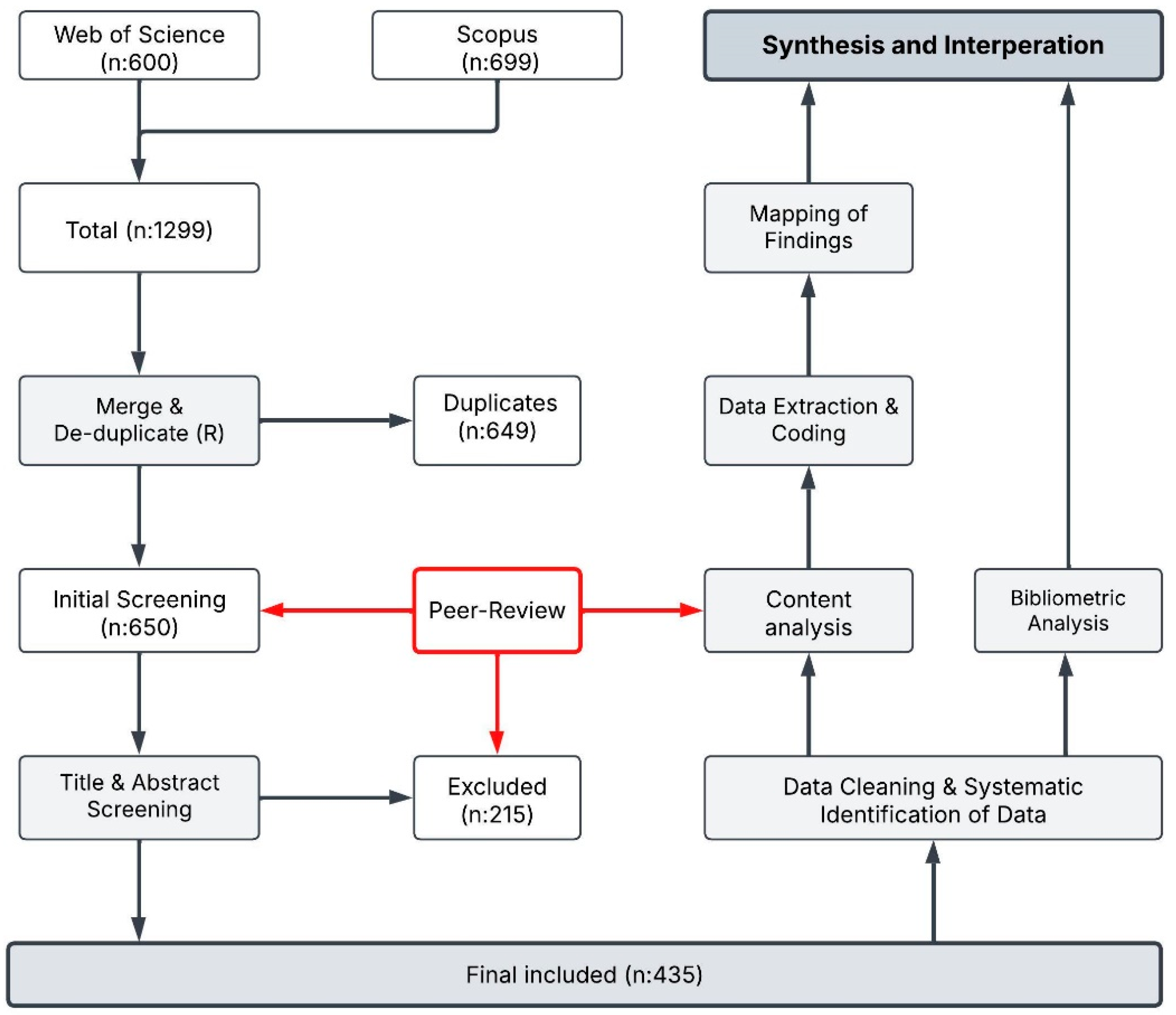
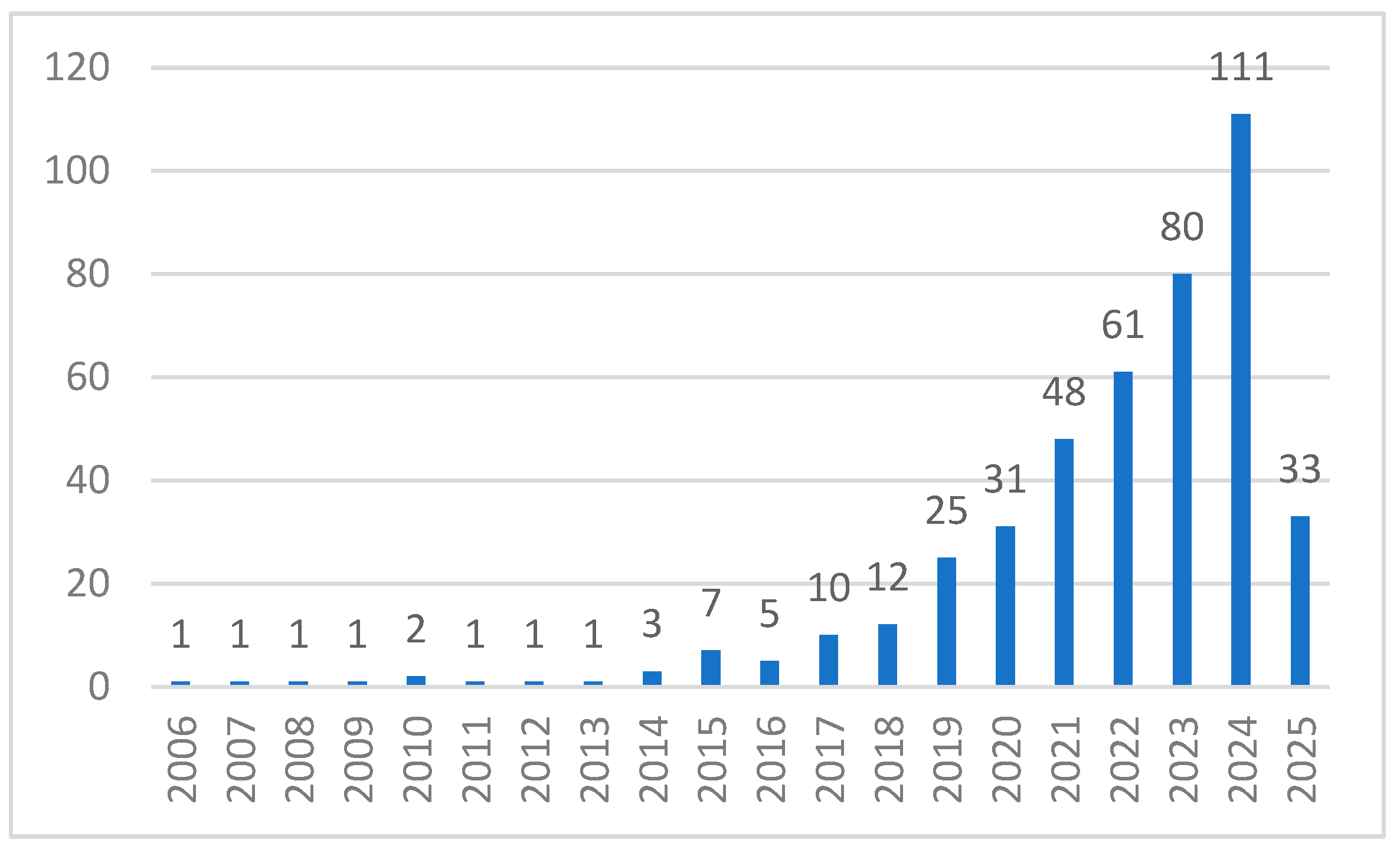

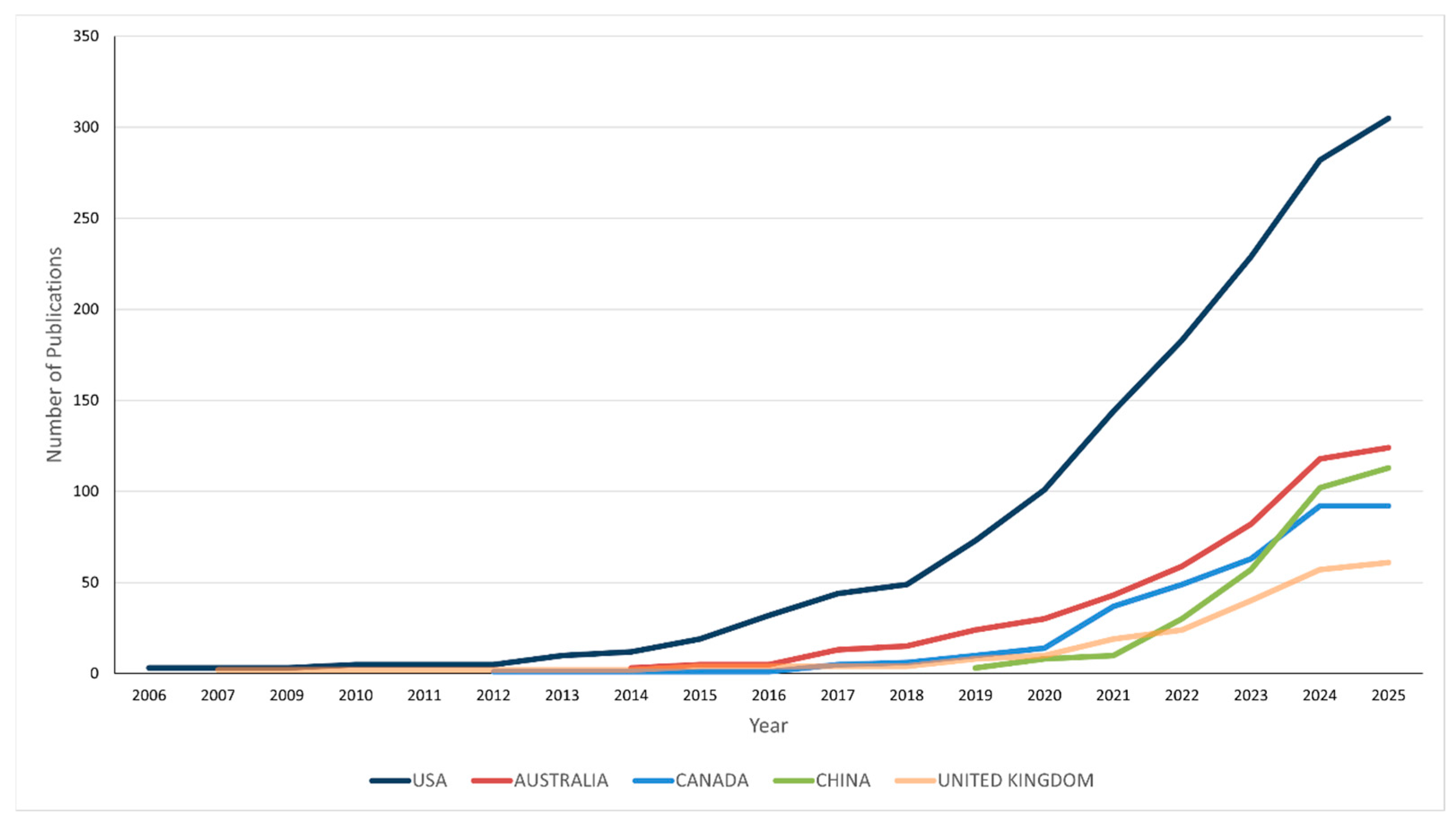
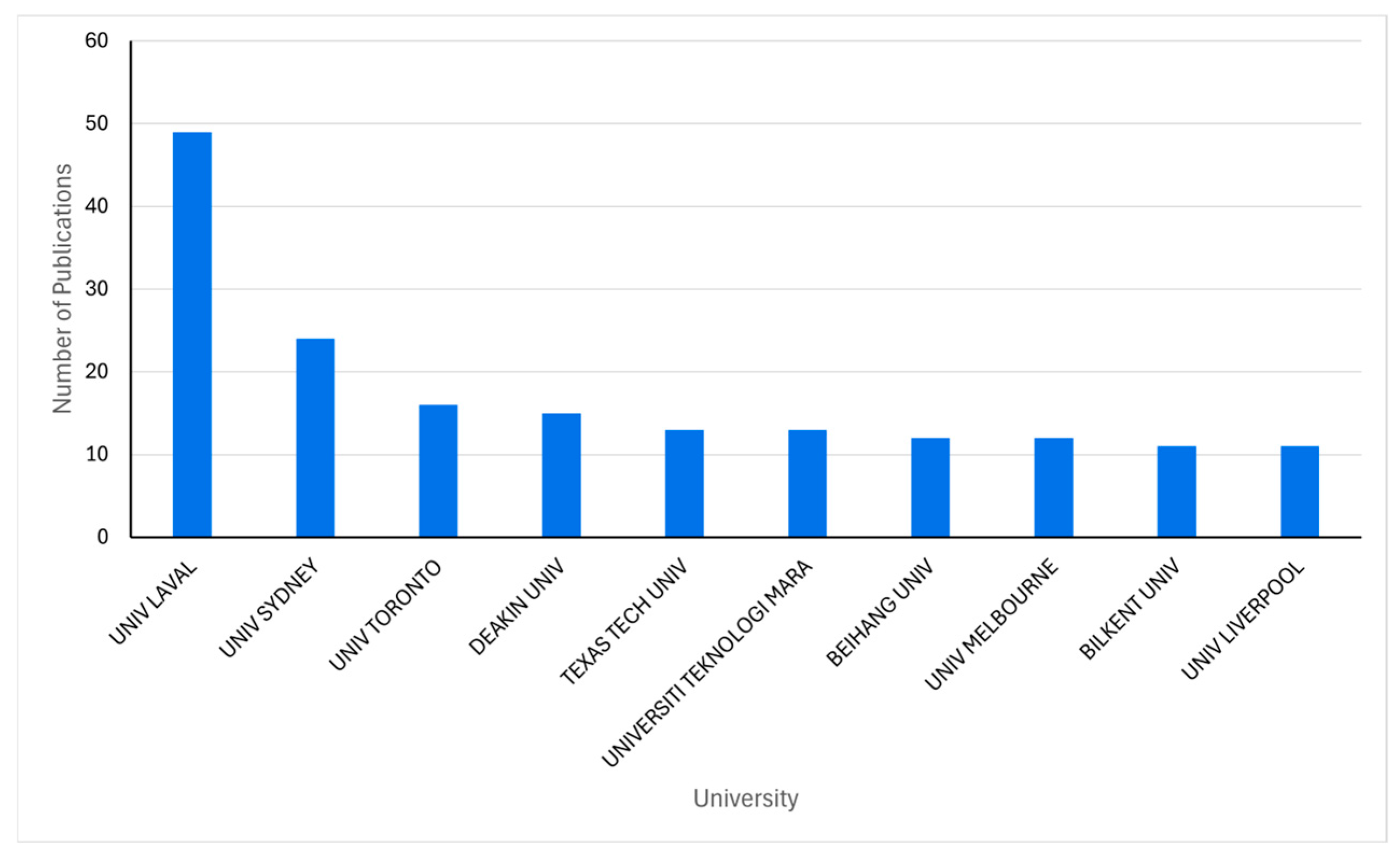
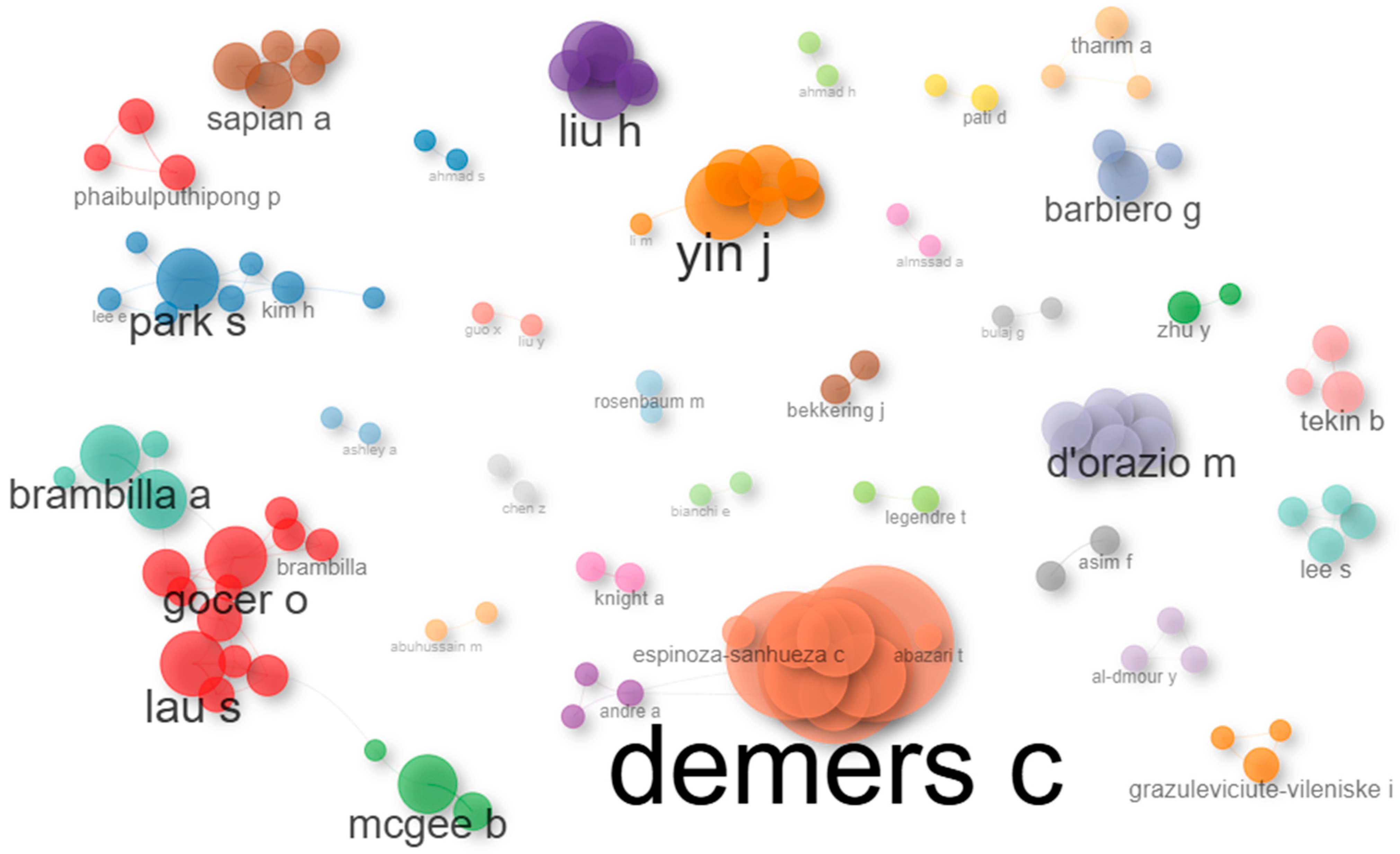
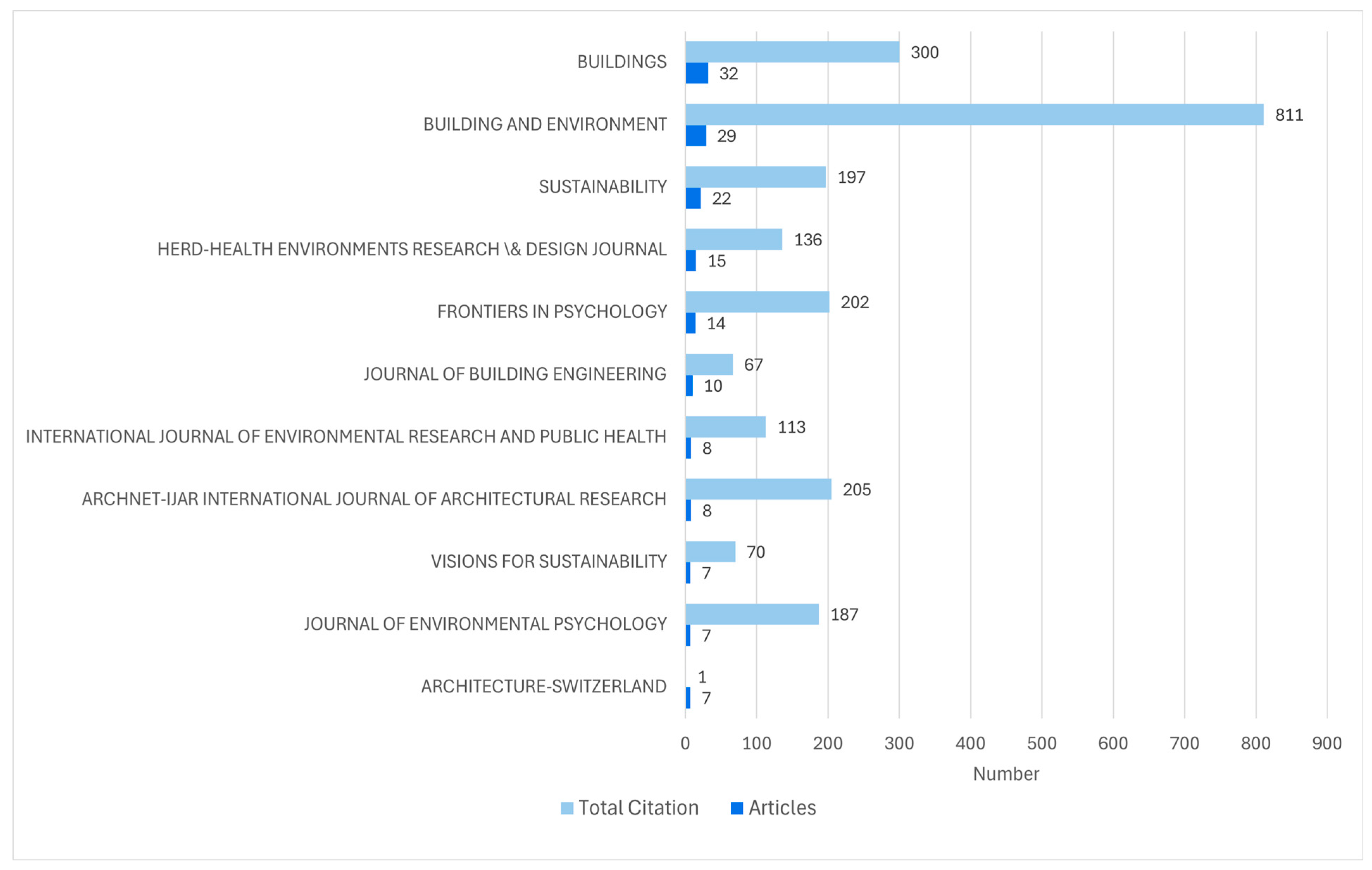

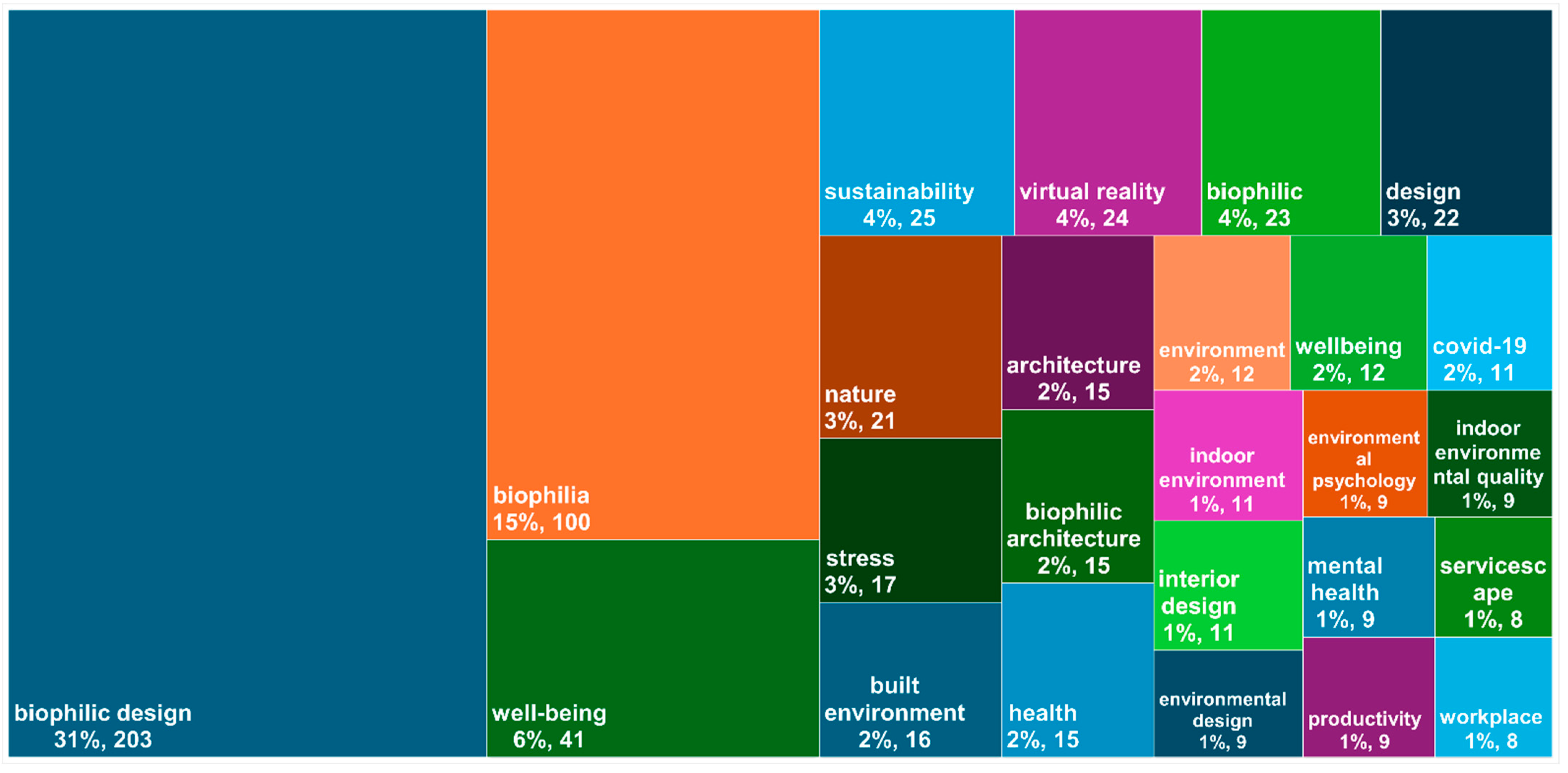


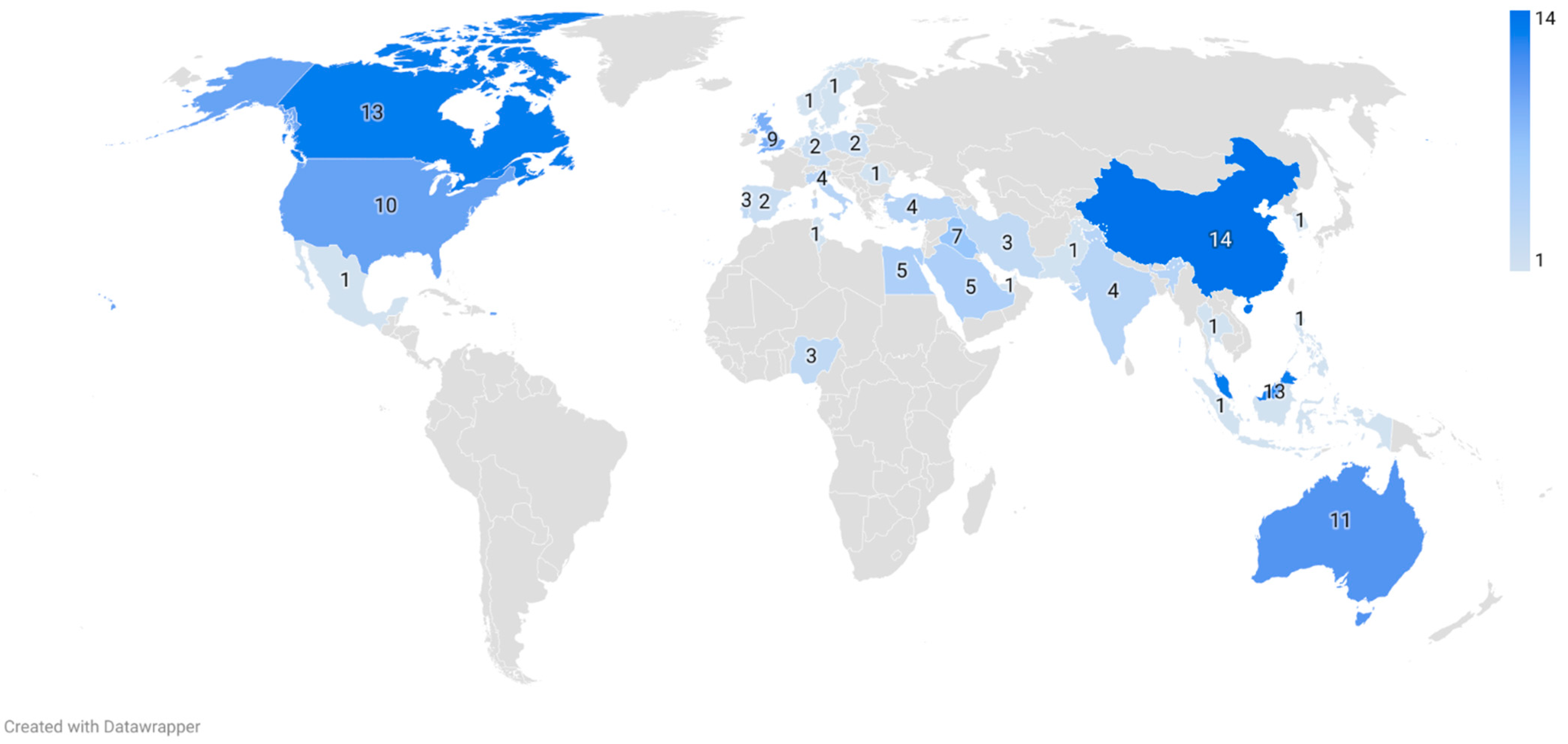
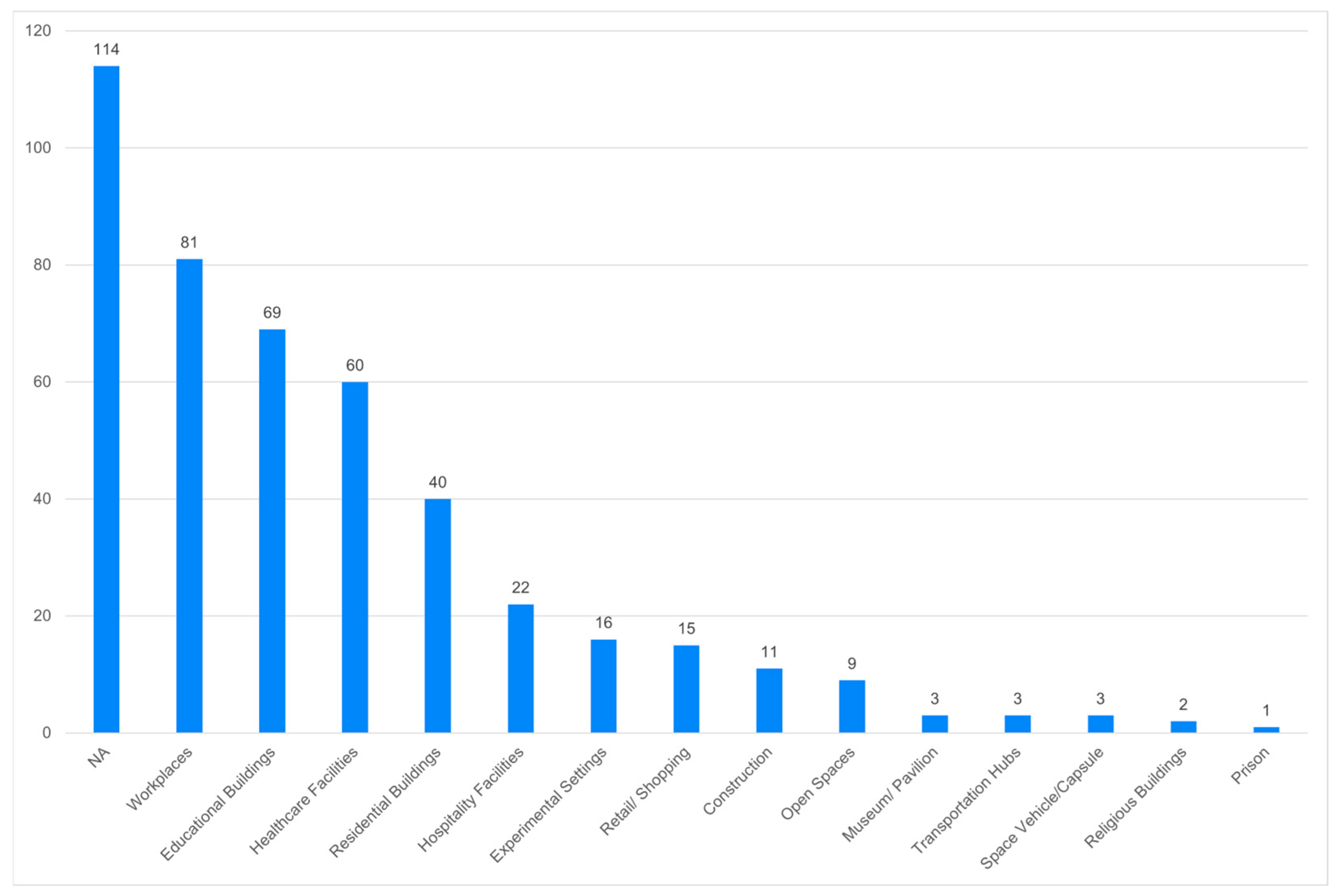
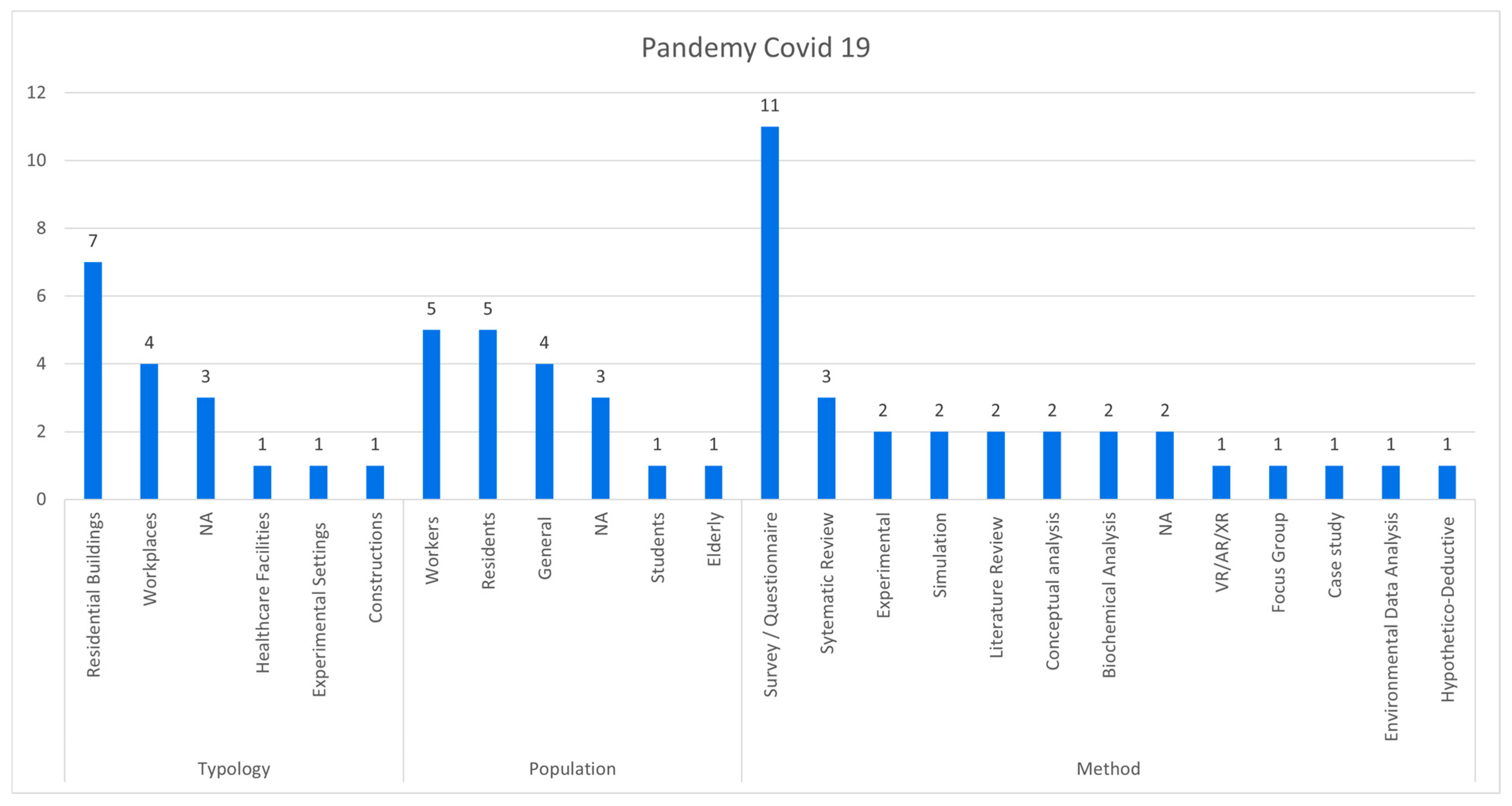
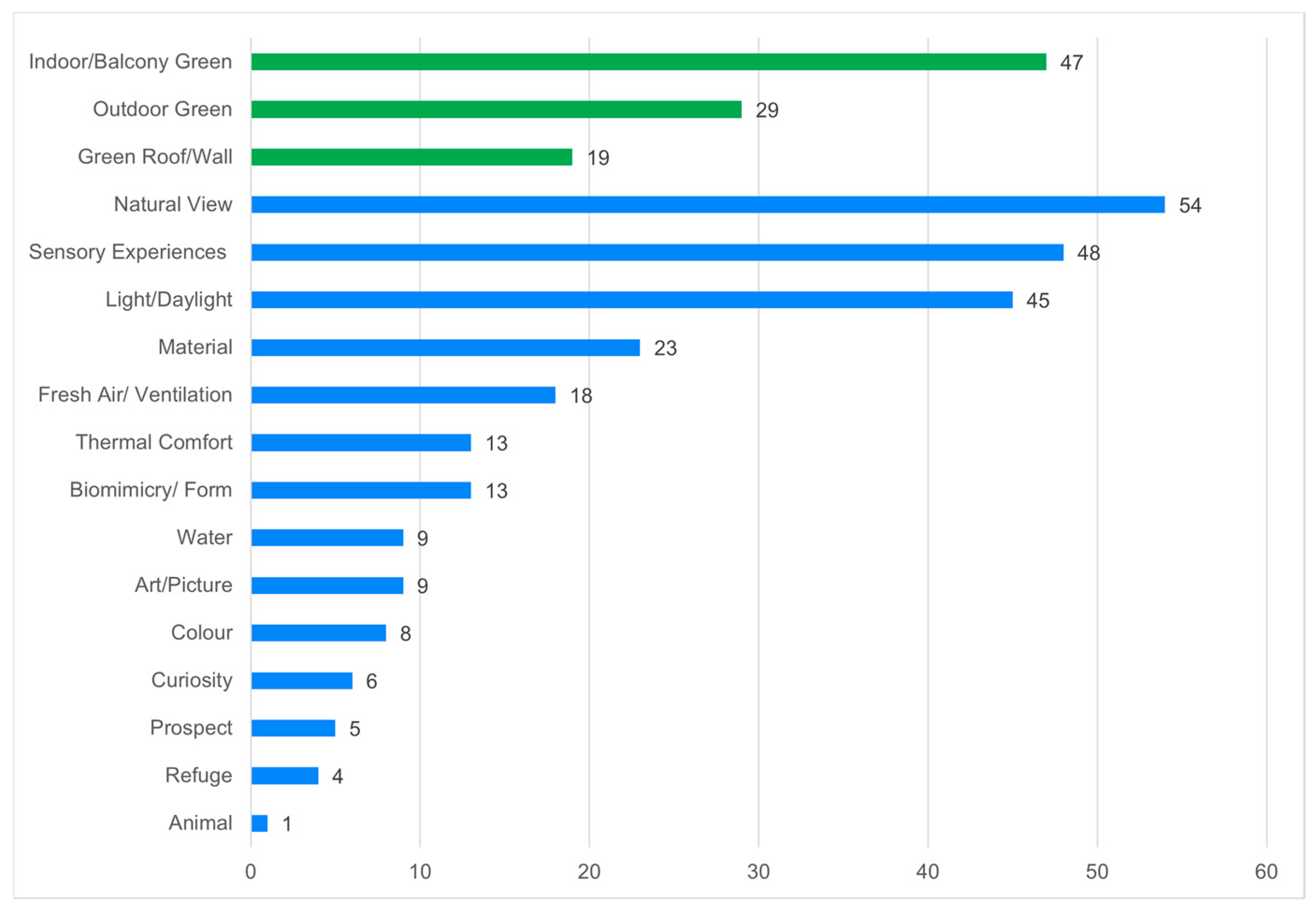

| Criterion Type | Applied Criteria |
|---|---|
| Inclusion | Peer-reviewed research articles or review papers |
| Published in English | |
| Explicitly or contextually focused on biophilic design. | |
| Conducted within the built environment context (architecture, interior design, buildings, public or institutional spaces) | |
| Exclusion | Use of the term “biophilic” in purely metaphorical, figurative, or branding contexts |
| Studies focused solely on biological, ecological, or environmental science perspectives unrelated to the built environment. | |
| Document types such as conference proceedings, book chapters, editorials, abstracts, or dataset-only publications | |
| Keyword-matching documents whose actual content does not address biophilic design |
| Climatic Conditions | Count |
|---|---|
| NA | 379 |
| Climate Reference (General) | 8 |
| Arid and Hot | 8 |
| Cold and Polar | 14 |
| Continental | 1 |
| Hot humid climate | 1 |
| Mild/Moderate | 5 |
| Subtropical | 2 |
| Tropic | 1 |
| Warm Mediterranean | 1 |
| General Climate Ref. | Continental | Arid and Hot | Warm Mediterranean | Tropic | Subtropical | Mild Moderate | Hot Humid | Cold and Polar | |
|---|---|---|---|---|---|---|---|---|---|
| Healthcare Facilities | 0 | 0 | 1 | 0 | 0 | 1 | 0 | 0 | 0 |
| Educational Buildings | 3 | 0 | 2 | 1 | 1 | 0 | 1 | 1 | 6 |
| Workplaces | 0 | 0 | 0 | 0 | 0 | 0 | 2 | 0 | 0 |
| Residential Buildings | 1 | 0 | 1 | 0 | 0 | 0 | 1 | 0 | 1 |
| Hospitality Facilities | 0 | 0 | 1 | 0 | 0 | 0 | 0 | 0 | 0 |
| Open Spaces | 0 | 0 | 1 | 0 | 0 | 0 | 0 | 0 | 0 |
| Museum/Pavilion | 0 | 0 | 1 | 0 | 0 | 0 | 0 | 0 | 0 |
| NA | 2 | 1 | 2 | 0 | 0 | 1 | 0 | 0 | 7 |
| General Climate Ref. | Continental | Arid and Hot | Warm Mediterranean | Tropic | Sub- Tropical | Mild Moderate | Hot Humid | Cold and Polar | |
|---|---|---|---|---|---|---|---|---|---|
| General/Holistic | 5 | 0 | 4 | 0 | 0 | 1 | 2 | 1 | 5 |
| Partial | 3 | 1 | 4 | 1 | 0 | 1 | 3 | 0 | 8 |
| Light/Daylight | 2 | 0 | 2 | 0 | 1 | 0 | 2 | 0 | 10 |
| Natural View | 2 | 0 | 1 | 0 | 0 | 1 | 2 | 0 | 5 |
| Outdoor Green | 2 | 0 | 3 | 1 | 0 | 0 | 0 | 0 | 1 |
| Indoor/Balcony Green | 3 | 0 | 1 | 0 | 1 | 1 | 1 | 0 | 0 |
| Green Roof/Wall | 0 | 1 | 1 | 0 | 0 | 1 | 1 | 0 | 0 |
| Artificial | 0 | 0 | 0 | 0 | 0 | 0 | 0 | 0 | 1 |
| Biomimicry-Form | 1 | 0 | 1 | 0 | 0 | 0 | 0 | 0 | 0 |
| Material | 1 | 0 | 1 | 0 | 0 | 0 | 0 | 0 | 0 |
| Water | 0 | 0 | 1 | 1 | 0 | 0 | 0 | 0 | 0 |
| Colour | 0 | 0 | 0 | 0 | 0 | 0 | 0 | 0 | 2 |
| Fresh Air- Ventilation | 1 | 0 | 2 | 0 | 1 | 1 | 1 | 0 | 3 |
| Sensory Experiences | 3 | 0 | 4 | 0 | 0 | 0 | 1 | 0 | 2 |
| Thermal Comfort | 0 | 0 | 1 | 0 | 0 | 0 | 1 | 0 | 4 |
| Animal | 0 | 0 | 0 | 0 | 0 | 0 | 0 | 0 | 0 |
| Prospect | 1 | 0 | 0 | 0 | 0 | 0 | 1 | 0 | 2 |
| Refuge | 1 | 0 | 0 | 0 | 0 | 0 | 1 | 0 | 1 |
| Curiosity | 2 | 0 | 0 | 0 | 0 | 0 | 1 | 0 | 1 |
| Workers | 104 | |
| Students | 68 | |
| Patients | 44 | |
| Guests | 33 | |
| Residents | 24 | |
| Age Based | Children | 24 |
| Adult | 1 | |
| Elderly | 10 | |
| Built Environment Professional | 17 | |
| General | 51 | |
| Space Explorers | 2 | |
| NA | 105 | |
| Workers | Students | Patients | Guests | Residents | Child | Adult | Elderly | Built Env. Experts | General | Space Exp. | NA | |
|---|---|---|---|---|---|---|---|---|---|---|---|---|
| Survey/ Questionnaire | 46 | 25 | 12 | 16 | 11 | 8 | 1 | 3 | 6 | 19 | 0 | 16 |
| Experimental | 26 | 20 | 9 | 10 | 5 | 5 | 0 | 1 | 1 | 13 | 0 | 13 |
| VR/AR/XR | 5 | 9 | 1 | 1 | 3 | 0 | 0 | 1 | 1 | 7 | 0 | 3 |
| Simulation | 7 | 2 | 2 | 0 | 4 | 0 | 0 | 0 | 0 | 4 | 0 | 8 |
| Interview | 7 | 3 | 3 | 2 | 5 | 4 | 0 | 1 | 4 | 1 | 0 | 3 |
| Focus Group | 4 | 5 | 0 | 1 | 0 | 1 | 0 | 0 | 1 | 0 | 0 | 2 |
| Observation | 15 | 7 | 6 | 3 | 3 | 4 | 0 | 0 | 1 | 3 | 0 | 13 |
| AI/Machine Learning | 0 | 1 | 1 | 0 | 0 | 0 | 0 | 0 | 1 | 0 | 0 | 2 |
| Bibliometric | 0 | 0 | 0 | 0 | 0 | 0 | 0 | 0 | 1 | 0 | 0 | 1 |
| Systematic Review | 13 | 2 | 6 | 2 | 2 | 2 | 0 | 2 | 0 | 5 | 0 | 11 |
| Content Analysis | 1 | 0 | 1 | 1 | 1 | 1 | 0 | 0 | 0 | 4 | 0 | 3 |
| Literature Review | 17 | 11 | 12 | 2 | 3 | 4 | 0 | 4 | 5 | 12 | 0 | 24 |
| Prototype Development | 0 | 2 | 0 | 1 | 0 | 0 | 0 | 0 | 1 | 1 | 0 | 3 |
| Participatory Design | 3 | 4 | 0 | 0 | 0 | 1 | 0 | 1 | 0 | 0 | 0 | 0 |
| Case Study | 16 | 15 | 7 | 8 | 4 | 8 | 0 | 0 | 2 | 9 | 0 | 15 |
| Conceptual Analysis | 12 | 5 | 7 | 4 | 2 | 3 | 0 | 0 | 6 | 11 | 2 | 17 |
| Environmental Data Anal. | 9 | 6 | 0 | 2 | 2 | 1 | 0 | 0 | 0 | 4 | 0 | 4 |
| Economic Value | 1 | 1 | 0 | 0 | 0 | 0 | 0 | 0 | 0 | 0 | 0 | 0 |
| Hypothetico-Deductive | 2 | 0 | 1 | 2 | 1 | 0 | 0 | 0 | 0 | 0 | 0 | 0 |
| Biochemical | 7 | 3 | 3 | 0 | 3 | 0 | 0 | 1 | 0 | 6 | 0 | 0 |
| Space Syntax | 1 | 1 | 0 | 0 | 0 | 0 | 0 | 0 | 0 | 0 | 0 | 1 |
| Behavioural Response | 2 | 3 | 0 | 0 | 0 | 2 | 0 | 0 | 0 | 1 | 0 | 1 |
| Decision-making Modelling | 0 | 0 | 0 | 1 | 0 | 0 | 0 | 0 | 0 | 0 | 0 | 0 |
| Diary Logs | 0 | 0 | 0 | 0 | 0 | 0 | 0 | 1 | 0 | 0 | 0 | 0 |
| Method Development | 1 | 1 | 0 | 0 | 1 | 0 | 0 | 1 | 1 | 0 | 0 | 0 |
| NA | 4 | 4 | 2 | 2 | 3 | 1 | 0 | 0 | 1 | 3 | 0 | 17 |
| Healthcare Facilities | Educational Buildings | Workplaces | Residential Buildings | Hospitality Facilities | Retail/ Shopping | Prisons | Open Spaces | Constructions | Experimental Settings | Religious Buildings | Museum/ Pavilion | Transportation Hubs | Space Vehicle/Capsule | NA | |
|---|---|---|---|---|---|---|---|---|---|---|---|---|---|---|---|
| Survey/ Questionnaire | 19 | 26 | 37 | 16 | 10 | 8 | 0 | 5 | 4 | 9 | 0 | 2 | 2 | 0 | 21 |
| Experimental | 11 | 14 | 30 | 7 | 8 | 4 | 0 | 3 | 3 | 13 | 0 | 0 | 1 | 0 | 12 |
| VR/AR/XR | 3 | 4 | 10 | 4 | 0 | 0 | 0 | 0 | 0 | 6 | 0 | 1 | 0 | 0 | 5 |
| Simulation | 4 | 1 | 5 | 6 | 0 | 0 | 0 | 0 | 0 | 1 | 0 | 0 | 1 | 0 | 9 |
| Interview | 4 | 6 | 4 | 5 | 2 | 1 | 0 | 0 | 0 | 0 | 0 | 0 | 0 | 0 | 5 |
| Focus Group | 0 | 3 | 2 | 1 | 0 | 1 | 0 | 0 | 2 | 0 | 0 | 0 | 0 | 0 | 4 |
| Observation | 8 | 14 | 9 | 4 | 2 | 1 | 0 | 3 | 0 | 0 | 2 | 1 | 0 | 0 | 8 |
| AI/Machine Learning | 1 | 1 | 0 | 0 | 0 | 0 | 0 | 0 | 1 | 1 | 0 | 0 | 0 | 0 | 2 |
| Bibliometric | 0 | 0 | 0 | 0 | 0 | 0 | 0 | 0 | 1 | 0 | 0 | 0 | 0 | 0 | 1 |
| Systematic Review | 7 | 4 | 8 | 4 | 1 | 1 | 0 | 0 | 1 | 0 | 0 | 0 | 0 | 0 | 13 |
| Content Analysis | 1 | 1 | 0 | 1 | 1 | 0 | 0 | 1 | 1 | 0 | 1 | 0 | 0 | 0 | 4 |
| Literature Review | 13 | 10 | 12 | 7 | 2 | 0 | 0 | 2 | 6 | 0 | 0 | 0 | 0 | 1 | 34 |
| Prototype Development | 0 | 1 | 0 | 1 | 1 | 0 | 0 | 0 | 1 | 0 | 0 | 0 | 0 | 0 | 4 |
| Participatory Design | 1 | 2 | 1 | 0 | 0 | 0 | 0 | 0 | 0 | 0 | 0 | 0 | 0 | 0 | 2 |
| Case Study | 11 | 16 | 11 | 9 | 4 | 4 | 0 | 3 | 2 | 1 | 0 | 1 | 2 | 0 | 9 |
| Conceptual Analysis | 9 | 3 | 6 | 4 | 4 | 1 | 0 | 2 | 5 | 0 | 0 | 0 | 0 | 2 | 23 |
| Environmental Data Anal. | 0 | 6 | 7 | 5 | 1 | 0 | 0 | 0 | 1 | 1 | 0 | 2 | 0 | 0 | 3 |
| Economic Value | 0 | 1 | 0 | 0 | 0 | 0 | 0 | 0 | 0 | 0 | 0 | 0 | 0 | 0 | 0 |
| Hypothetico-Deductive | 1 | 0 | 2 | 1 | 1 | 1 | 0 | 0 | 0 | 1 | 0 | 0 | 0 | 0 | 0 |
| Biochemical | 4 | 3 | 8 | 3 | 0 | 0 | 0 | 0 | 0 | 3 | 0 | 0 | 0 | 0 | 2 |
| Space Syntax | 0 | 1 | 0 | 1 | 0 | 0 | 0 | 0 | 0 | 0 | 0 | 0 | 0 | 0 | 0 |
| Behavioural Response | 0 | 2 | 2 | 1 | 0 | 0 | 0 | 0 | 1 | 1 | 0 | 0 | 0 | 0 | 1 |
| Decision-making Modelling | 0 | 0 | 0 | 0 | 1 | 0 | 0 | 0 | 0 | 0 | 0 | 0 | 0 | 0 | 0 |
| Diary Logs | 0 | 0 | 0 | 1 | 0 | 0 | 0 | 0 | 0 | 0 | 0 | 0 | 0 | 0 | 0 |
| Method Development | 1 | 1 | 0 | 1 | 0 | 0 | 0 | 0 | 0 | 0 | 0 | 0 | 0 | 0 | 1 |
| NA | 3 | 5 | 4 | 4 | 0 | 2 | 1 | 0 | 0 | 1 | 0 | 0 | 0 | 0 | 14 |
| Healthcare Facilities | Educational Buildings | Workplaces | Residential Buildings | Hospitality Facilities | Retail/ Shopping | Prisons | Open Spaces | Constructions | Experimental Settings | Religious Buildings | Museum/ Pavilion | Transportation Hubs | Space Vehicle/ Capsule | NA | |
|---|---|---|---|---|---|---|---|---|---|---|---|---|---|---|---|
| General/ Holistic | 32 | 45 | 49 | 27 | 15 | 10 | 1 | 4 | 8 | 5 | 1 | 1 | 2 | 3 | 67 |
| Partial | 27 | 20 | 27 | 13 | 7 | 5 | 0 | 4 | 3 | 11 | 1 | 2 | 0 | 0 | 42 |
| Light/ Daylight | 13 | 15 | 25 | 9 | 4 | 0 | 0 | 2 | 1 | 1 | 0 | 2 | 0 | 0 | 18 |
| Natural View | 23 | 12 | 19 | 5 | 3 | 1 | 0 | 1 | 0 | 5 | 0 | 0 | 0 | 0 | 16 |
| Outdoor Green | 7 | 11 | 4 | 3 | 3 | 2 | 0 | 6 | 1 | 0 | 0 | 0 | 0 | 0 | 9 |
| Indoor/Balcony Green | 12 | 13 | 15 | 9 | 4 | 6 | 0 | 1 | 0 | 6 | 0 | 1 | 0 | 0 | 13 |
| Green Roof/Wall | 3 | 2 | 4 | 1 | 1 | 0 | 0 | 0 | 1 | 0 | 0 | 0 | 0 | 0 | 9 |
| Artificial | 3 | 1 | 1 | 0 | 0 | 0 | 0 | 0 | 0 | 1 | 0 | 0 | 0 | 0 | 5 |
| Biomimicry-Form | 1 | 4 | 1 | 1 | 1 | 3 | 0 | 0 | 1 | 0 | 1 | 1 | 0 | 0 | 10 |
| Material | 7 | 9 | 10 | 7 | 1 | 3 | 0 | 2 | 3 | 2 | 0 | 1 | 0 | 0 | 5 |
| Water | 3 | 7 | 3 | 4 | 1 | 1 | 0 | 2 | 0 | 0 | 0 | 1 | 0 | 0 | 2 |
| Colour | 3 | 0 | 3 | 0 | 0 | 1 | 0 | 1 | 1 | 0 | 0 | 0 | 0 | 0 | 5 |
| Fresh Air-Ventilation | 5 | 10 | 7 | 5 | 1 | 0 | 0 | 0 | 0 | 0 | 0 | 0 | 0 | 0 | 9 |
| Sensory Experiences | 16 | 14 | 20 | 13 | 5 | 2 | 0 | 3 | 1 | 5 | 0 | 0 | 0 | 0 | 17 |
| Thermal Comfort | 1 | 5 | 8 | 5 | 0 | 0 | 0 | 1 | 0 | 1 | 0 | 0 | 0 | 0 | 6 |
| Animal | 0 | 1 | 0 | 0 | 0 | 0 | 0 | 0 | 0 | 0 | 0 | 0 | 0 | 0 | 0 |
| Prospect | 3 | 5 | 3 | 2 | 1 | 2 | 0 | 0 | 0 | 0 | 0 | 0 | 0 | 0 | 2 |
| Refuge | 2 | 3 | 4 | 2 | 1 | 0 | 0 | 0 | 0 | 0 | 0 | 0 | 0 | 0 | 2 |
| Curiosity | 0 | 5 | 4 | 3 | 3 | 1 | 0 | 0 | 0 | 1 | 0 | 0 | 0 | 0 | 2 |
| Heritage | Standards Regulations | Theory (General) | Academic Education | |
|---|---|---|---|---|
| Survey/Questionnaire | 2 | 9 | 21 | 11 |
| Experimental | 0 | 4 | 12 | 8 |
| VR/AR/XR | 0 | 1 | 1 | 3 |
| Simulation | 0 | 2 | 2 | 0 |
| Interview | 0 | 5 | 4 | 2 |
| Focus Group | 0 | 1 | 1 | 4 |
| Observation | 4 | 6 | 10 | 4 |
| AI/Machine Learning | 0 | 0 | 1 | 1 |
| Bibliometric | 0 | 0 | 0 | 0 |
| Systematic Review | 1 | 2 | 12 | 0 |
| Content Analysis | 2 | 4 | 4 | 1 |
| Literature Review | 1 | 16 | 23 | 6 |
| Prototype Development | 1 | 2 | 1 | 2 |
| Participatory Design | 0 | 1 | 0 | 2 |
| Case Study | 1 | 7 | 18 | 6 |
| Conceptual Analysis | 3 | 13 | 25 | 4 |
| Environmental Data Anal. | 0 | 3 | 4 | 4 |
| Economic Value | 0 | 0 | 0 | 1 |
| Hypothetico-Deductive | 0 | 0 | 4 | 0 |
| Biochemical | 0 | 2 | 2 | 2 |
| Space Syntax | 0 | 0 | 0 | 0 |
| Behavioural Response | 0 | 0 | 1 | 1 |
| Decision-making Modelling | 0 | 0 | 0 | 0 |
| Diary Logs | 0 | 0 | 1 | 0 |
| Method Development | 0 | 1 | 0 | 1 |
| NA | 2 | 1 | 4 | 0 |
| Trend | Description |
|---|---|
| Acceleration of Research Post-2020 | Research output sharply increased after 2019, reflecting growing concerns about health and well-being in indoor environments due to the COVID-19 pandemic. |
| Interdisciplinary Expansion | Research spans architecture, psychology, public health, sustainability, and digital technology, with converging interests in VR, mental health, and ecological outcomes. |
| Dominance of Institutional Typologies | Workplaces, schools, and hospitals are most studied due to their direct link with measurable cognitive, emotional, and productivity benefits. |
| Empirical Orientation | Surveys and experimental designs dominate, emphasizing subjective user perceptions and measurable environmental satisfaction. |
| Technological Integration | The use of VR, simulation, and biometric methods is increasing, albeit still limited, and offers new modalities for immersive and precise evaluation. |
| Rapid Mainstreaming Post-2019 | Publication output rose sharply after 2019, driven by pandemic-related interest in indoor environments and wellness-focused design. |
| Global and Interdisciplinary Expansion | While early research was concentrated in North America and Europe, recent growth in China, Malaysia, and Australia highlights global uptake. Research themes now integrate environmental psychology, sustainability, and digital technologies. |
| Institutional and Workplace Dominance | Workplaces, schools, and healthcare buildings continue to dominate in both empirical focus and typological representation. |
| Surveys and Experiments Prevail | User-centred studies heavily rely on perception-based tools (e.g., surveys, experiments), particularly in institutional contexts. |
| Emerging Use of VR/AR and Simulation | Though limited, interest in immersive and predictive technologies is growing, especially in education and experimental settings. |
| Greenery and Visual Comfort Prioritized | Greenery, daylight, and views of nature remain the most frequently studied parameters, often linked to productivity and well-being. |
| Gap | Description |
|---|---|
| Lack of Climate-Specific Frameworks | Only 56 studies mention climate; there is a significant lack of location-sensitive design principles. |
| Cultural and Heritage Underrepresentation | Cultural references are scarce, with only 15 studies exploring traditional or symbolic meanings of nature. |
| User Group Imbalance | Research largely neglects elderly, neurodiverse, and marginalised communities; the focus is primarily on institutional populations. |
| Typological Narrowness | Critical building types like retail, transit, religious spaces, and detention facilities are underexplored. |
| Overlooked Psychological Parameters | Despite their theoretical importance, the Prospect, refuge, and symbolic representations of nature are seldom addressed. |
| Fragmented Research Networks | Most research is regional, with few extensive or interdisciplinary collaborations that could support standardisation and scalability. |
| Underutilization of Advanced Technologies | Technological tools such as VR/AR, simulation, biometric tracking, and AI are still rarely employed in biophilic design research. |
| Lack of Experimental and Neuroscience-Informed Research | Experimental exploration of the field remains insufficient. Among the few studies engaging with neuroarchitecture, only two employed experimental methods, highlighting a substantial gap in the integration of neuroscience-based experimentation |
| Neglected Cultural Contexts | Only 15 acknowledge cultural context, revealing a serious contextual blind spot. |
| Lack of Contextual Diversity | Despite the global relevance of biophilic design, the literature is heavily concentrated in Western regions. There is minimal representation from Global South contexts. |
| Underrepresentation of Critical Typologies | Prisons, transit hubs, sanctuaries, and extreme environments (e.g., space habitats) are virtually absent, despite their high-stress nature. |
| Psychological and Symbolic Parameters Overlooked | Refuge, curiosity, prospect, and animal presence are rarely examined, despite being central to biophilic theory. |
| Minimal Focus on Vulnerable Populations | Children, older adults, neurodivergent individuals, and marginalised communities are consistently understudied across all typologies. |
| Fragmented Collaboration and Regional Isolation | Most author teams are small (2–4 people) and regionally clustered, limiting methodological standardisation and international relevance. |
| Overreliance on Holistic but Vague Mentions | Two hundred fifty-nine studies refer to biophilic design in general terms, but only a subset of 157 focus in depth on specific, measurable parameters. |
| Direction | Description |
|---|---|
| Climate-Responsive Design | Develop frameworks tailored to environmental zones, with adaptive use of light, vegetation, and thermal features. |
| Cultural Integration | Incorporate cultural narratives and regional traditions into design strategies; address intangible heritage through space. |
| Inclusive Research | Focus on the needs of elderly, cognitively diverse, and underserved users via participatory and ethnographic approaches. |
| Expand Building Typologies | Investigate transit, retail, sanctuary, and correctional facilities to improve psychological well-being in neglected contexts. |
| Longitudinal and Mixed Methods | Combine physiological, spatial, and self-report tools over time to measure effects holistically. |
| Advanced Technologies | Employ AI, wearables, and real-time feedback systems to inform design and measure performance in dynamic settings. |
| Adaptive Systems and Smart Buildings | Apply biophilic and neuroarchitectural insights to develop intelligent buildings with adaptive systems that respond to user needs through sensors, neurofeedback, and context-aware technologies, enhancing well-being and performance. |
| Global Collaboration | Build international partnerships to ensure metric standardisation, cultural applicability, and data-driven policymaking. |
| Incorporate Cultural and Heritage-Sensitive Design | Include spiritual, symbolic, and vernacular aspects of nature integration, particularly in heritage buildings and sacred spaces. |
| Expand to High-Stress and Underserved Typologies | Explore biophilic strategies in prisons, public transportation, religious spaces, and housing for vulnerable populations. |
| Expand Experimental Exploration | Increase the use of experimental methods to empirically assess the effects of biophilic and neuroarchitectural design elements on human cognition, emotion, and physiology, enabling stronger causal inferences and evidence-based practice. Use tools such as brain imaging, biometric sensors, and neurocognitive performance metrics. |
| Bridge Empirical Gaps with Longitudinal Mixed Methods | Combine biometric data (e.g., cortisol, HRV) and spatial analysis with qualitative interviews to understand long-term effects. |
| Integrate Neglected Parameters | Advance multisensory and psychological dimensions such as soundscapes, tactile materials, refuge, and curiosity. |
| Strengthen Cross-Sectoral and Global Collaboration | Build international, interdisciplinary networks to standardise biophilic indicators, improve comparative validity, and co-develop policy frameworks. |
Disclaimer/Publisher’s Note: The statements, opinions and data contained in all publications are solely those of the individual author(s) and contributor(s) and not of MDPI and/or the editor(s). MDPI and/or the editor(s) disclaim responsibility for any injury to people or property resulting from any ideas, methods, instructions or products referred to in the content. |
© 2025 by the authors. Licensee MDPI, Basel, Switzerland. This article is an open access article distributed under the terms and conditions of the Creative Commons Attribution (CC BY) license (https://creativecommons.org/licenses/by/4.0/).
Share and Cite
Tekin, B.H.; Izmir Tunahan, G.; Disci, Z.N.; Ozer, H.S. Biophilic Design in the Built Environment: Trends, Gaps and Future Directions. Buildings 2025, 15, 2516. https://doi.org/10.3390/buildings15142516
Tekin BH, Izmir Tunahan G, Disci ZN, Ozer HS. Biophilic Design in the Built Environment: Trends, Gaps and Future Directions. Buildings. 2025; 15(14):2516. https://doi.org/10.3390/buildings15142516
Chicago/Turabian StyleTekin, Bekir Hüseyin, Gizem Izmir Tunahan, Zehra Nur Disci, and Hatice Sule Ozer. 2025. "Biophilic Design in the Built Environment: Trends, Gaps and Future Directions" Buildings 15, no. 14: 2516. https://doi.org/10.3390/buildings15142516
APA StyleTekin, B. H., Izmir Tunahan, G., Disci, Z. N., & Ozer, H. S. (2025). Biophilic Design in the Built Environment: Trends, Gaps and Future Directions. Buildings, 15(14), 2516. https://doi.org/10.3390/buildings15142516










